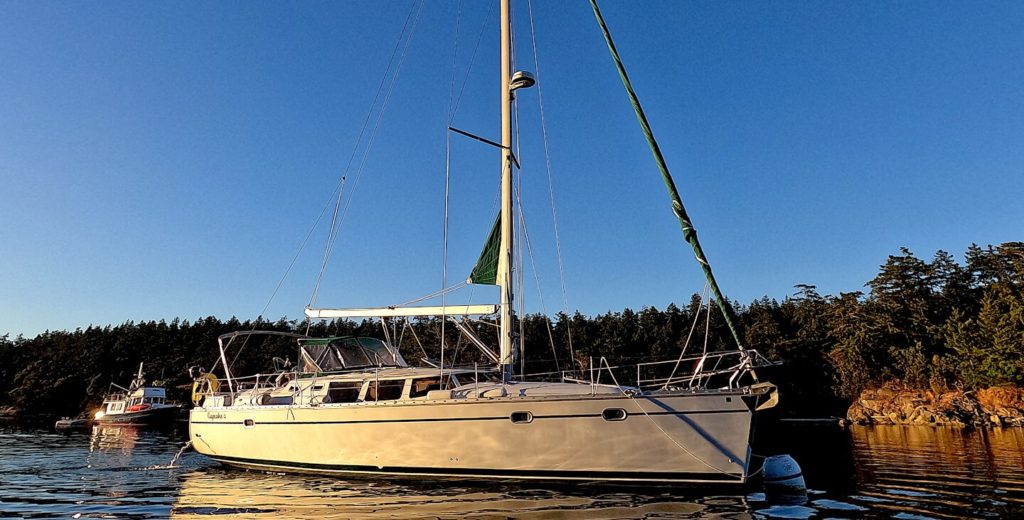
The Jeanneau 43 DS introduced a “deck saloon” layout to the Jeanneau cruising sailboat line. Does this design offer any worthwhile advantage? We chartered one, named Cupcake, for a four day romp through the San Juan Islands to find out.
The Good
- Incredibly easy to maneuver in close quarters
- Handsome looks (in my opinion anyway)
- Lots of headroom and light in the cabin areas
- Generous sleeping arrangements
The Bad
- Berth space writes checks the rest of the boat can’t cash
- Lots of steps to stub your toes and twist your ankles
- Boarding from a dock requires strength, dexterity, and modest clothing
- Large windows and marginal ventilation not ideal in warmer climes
What is the Jeanneau 43 Deck Saloon
In short, the Jeanneau 43 is a production cruising sailboat with some nicer touches that position it somewhere in the upper half of the market. People have no doubt crossed oceans in these boats, but they are most likely to be used near shore.
The Jeanneau 43 “Deck Saloon,” or DS for short, was a riff on the original Jeanneau Sun Odyssey (SO for short). While both models have the same capacities and options, the DS version has a wider, raised cabin roof that allows for more headroom in the salon (or saloon, if you will) and aft (rear) staterooms. The raised roof also allows more light into the salon from larger side windows and the addition of forward salon windows. Everything in boating is a tradeoff, and in the case of the Deck Saloon, you loose some width on the side decks. For whatever reason, the SO also deletes the separate shower stall in the DS for a slightly larger seat next to the nav table.

Between the two designs, I definitely prefer the DS that we chartered, but I’d be happy with either. I personally find the upright windows to create a distinctive, handsome, timeless look, but I realize others deride it. Perhaps most importantly, my crew likes the dedicated shower stall. In the Pacific Northwest, the extra light in the salon is welcome, but this would just let in more unwelcome heat in warmer climates. The side decks on the DS were generous enough to move safely to the bow under-way, so that was not a detractor at all.
How Big is the Jeanneau 43 DS?
While there are several layouts available, our bareboat charter had the most dense sleeping configuration with with three double berths and two bunks across three cabins, plus a large settee (table and bench) that converts to a large bed. We found that the number of berths make promises the rest of the boat can’t deliver. With four adults and two children aboard (using 6 of 8 berths), we were on the edge of comfort in the cockpit and and salon. We would have felt very crowded with two more aboard.
Cupcake carries a very generous beam that, combined with her high freeboard, can make her a bit challenging to dock: it’s hard to tell how close you are to the dock from the helm, and your mate has a big leap down to the dock regardless of that distance.

At the Helm of the Jeanneau 43 DS
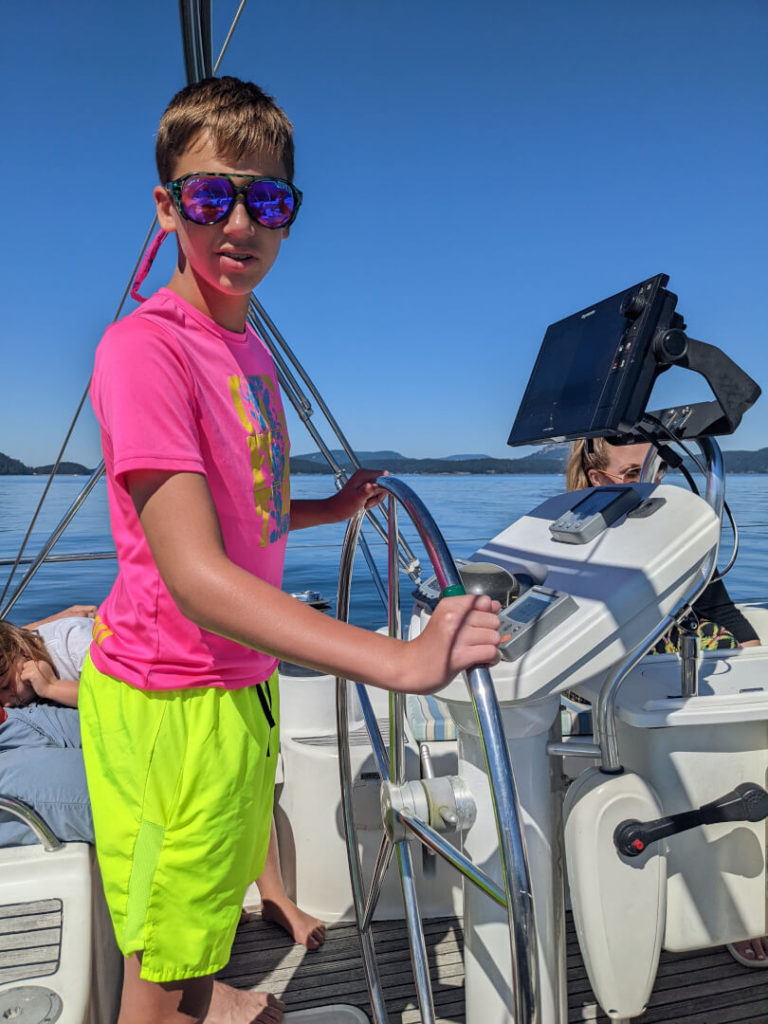
Our Jeanneau 43 DS was equipeed with a pedestal mounted helm on the centerline at the rear of the cockpit.
I found it hard to see forward while sitting on the bench behind the center helm because it was too low relative to the binnacle mounted electronics, despite me being 6 feet tall. While standing, visibility was somewhat restricted by the dodger right in the center of my line of sight. The vinyl on the dodger also makes it hard to spot logs…a very real hazard in the San Juan Islands. So I found myself craning out to the left or right from time to time to make sure I wasn’t missing any traffic headed our way. Additionally, when coming alongside a dock bow first, I could not see how close we were to the dock from the helm. When other members of the crew had the wheel, I found the most comfortable position for good lookout was to stand in the stern stairwell to get lower than standing in the cockpit, but higher than sitting. We did find that smaller skippers (children) were comfortable standing on the bench when taking the wheel.
In lieu of a rudder indicator, our ships’ wheel had a green piece of tape marking straight ahead. Since the wheel made just over one full turn in each direction, this was very effective, intuitive, and simple.
The engine control panel was mounted out of the way beneath the helm seat. As long as you didn’t need it, that was great. But it was a real PITA to read the tachometer or check the other gauges while under way. The throttle is mounted on the binnacle in front of the wheel. While that puts it within close reach, you’ve got the reach through or around the wheel to get to it, which isn’t ideal when docking.

Does the Jeanneau 43 DS Have Lower Helm?
While the exterior design of the Jeanneau 43 DS makes the salon look like a pilothouse, there is no lower helm to control the boat from below deck. In fact, the windows are too small and mounted too high to maintain a safe lookout from the salon. Too bad, because this configuration would be very welcome here in the San Juan Islands where you can run into cold, wet weather any time of year. The Beneteau Evasion 36 has similar lines to the Jeanneau 43 DS, but is in fact designed with a lower helm as a true pilothouse.
Electronics
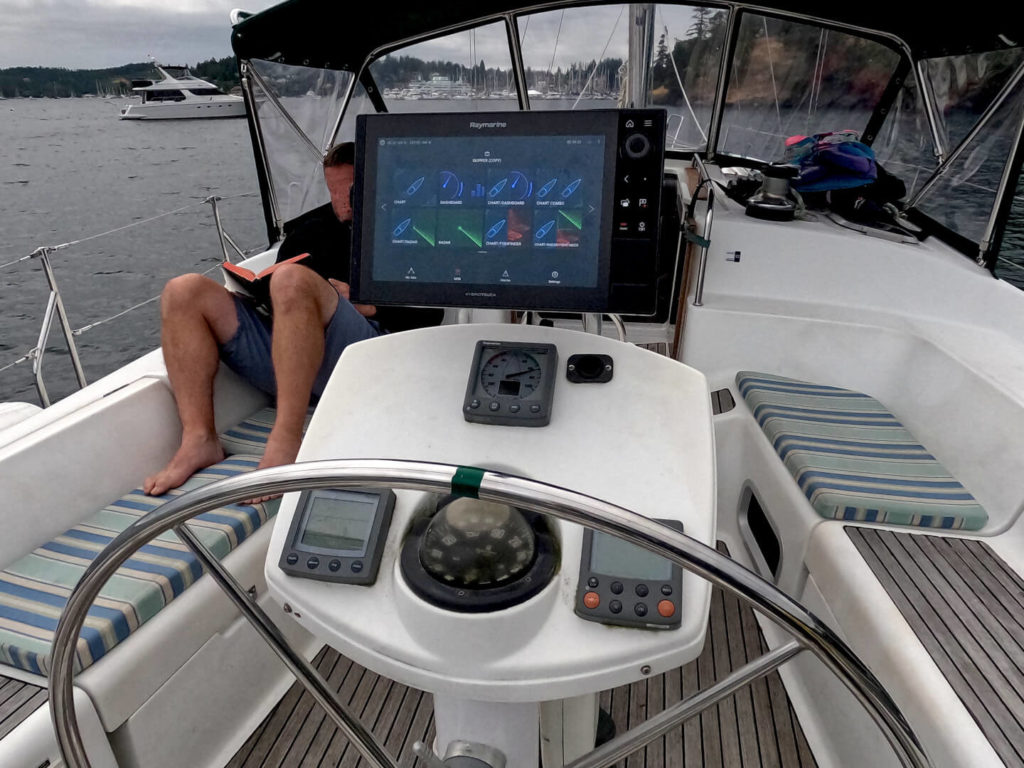
Cupcake came well equipped with a Raymarine digital autohelm, windicator, and instrument display at the helm A Raymarine multifunction display was installed above this.. The display was not integrated with the older analog engine or tank monitors, However, it was equipped with a radar, which is very useful for monitoring traffic, especially on foggy mornings in the San Juan Islands. An AIS would have been nice to be able to see fast moving ferries hidden by the taller islands, but this boat was not so equipped. The radar had ARPA target acquisition, which allows you to touch a blob on the screen (theoretically a boat) to ask the system to track it. It would then plot a heading line to help you determine how close it would come to your path, and if you needed to change course.
We did have a few problems with the electronics:
- The radar was much more effective at finding sailboats than even good sized powerboats: We had a code brown moment when a 57′ Bayliner appeared out of the fog just off our stern without ever making much noise on the radar.
- I was surprised at how much heat the multifunction display generated. After running for a few hours, the touchscreen was hot to the, uh, touch.
- The water speed indicator always shows a much slower speed than we were actually travelling
- The wind direction displayed directional readings that just didn’t make any sense, but we were able to rely on the windex mounted on top of the mast while sailing.
- The worst problem we had with the electronics was the autohelm. While we were circumnavigating San Juan Island, the autohelm have us a loud beep and stopped holding our course. I reset the power to get it going and it did the same thing several more times. So we had several hours of cruising with manual steering. Normally, to my consternation, George loves to run the boats without using the autohelm…but today, the one time this habit came in handy, he wasn’t interested in anything but taking a nap.

While most of the electronics were available at the helm, the stereo and VHF were both mounted at the nav station. There was also a handheld VHF that we were able to keep at the helm while under way. The handheld charger, however, was attached to the 120v shorepower system, so you’d need to move if to the inverter to keep it charged on a longer passage. A 12-volt connection would be a welcome improvement.
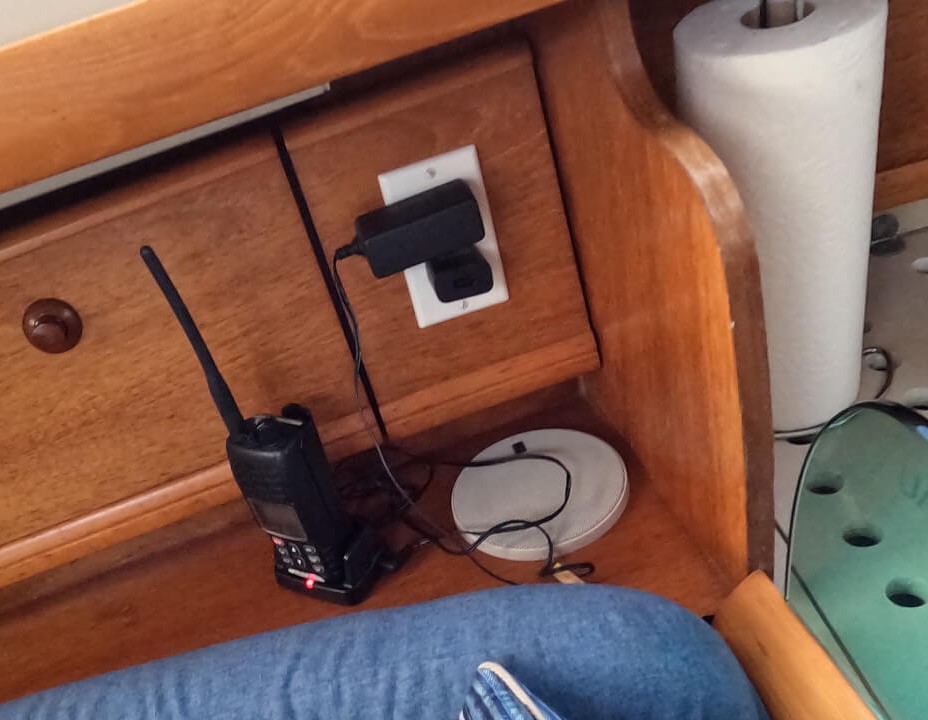
Under Way in the Jeanneau 43 DS
During our charter, we were able to circumnavigate San Juan Island on the same test route as we took on the Nordic Tug 26. However, this time we were brave enough to cut through Mosquito Pass, which saved a bit of time and gave us some beautiful views. We took advantage of a high tide that gave us an extra 7 feet of water to navigate our 6.5 ft draft keel through the narrow channel. By the time we got down to Lime Kiln Point, the fog rolled in something fierce, we slowed down and kept an eye on the radar. Our boat did not have a built in horn at the helm, so we relied on the provided air can horn. While it was perfectly effective, it was very loud in the cockpit, and I had to warn the crew to close their ears each time I sounded it.
How Does the Jeanneau 43 DS Handle Rough Seas?
The week of our bareboat charter brought spring tides to the Salish Sea. Spring Tides are uneven tides in which one of the daily tidal cycles is flat and the other is twice normal…something to do with the moon phase. On our journey around San Juan Island, this put us against the incoming tide (Xkts current) heading south, and with the tide as we headed back north. We saw some of the calmest water that I’ve ever seen down in the Straight of Juan de Fuca that day, so we never got a good chance to bounce around in a choppy sea. However, the boat had enough power to keep us making forward progress with the strong currents at our bow, and enough rudder to give us good control when we had the seas at our stern. I’m sure the freeboard that made it so hard for us to climb in from the dock will keep your crew nice and dry when things get rough.
Sailing the Jeanneau 43 DS
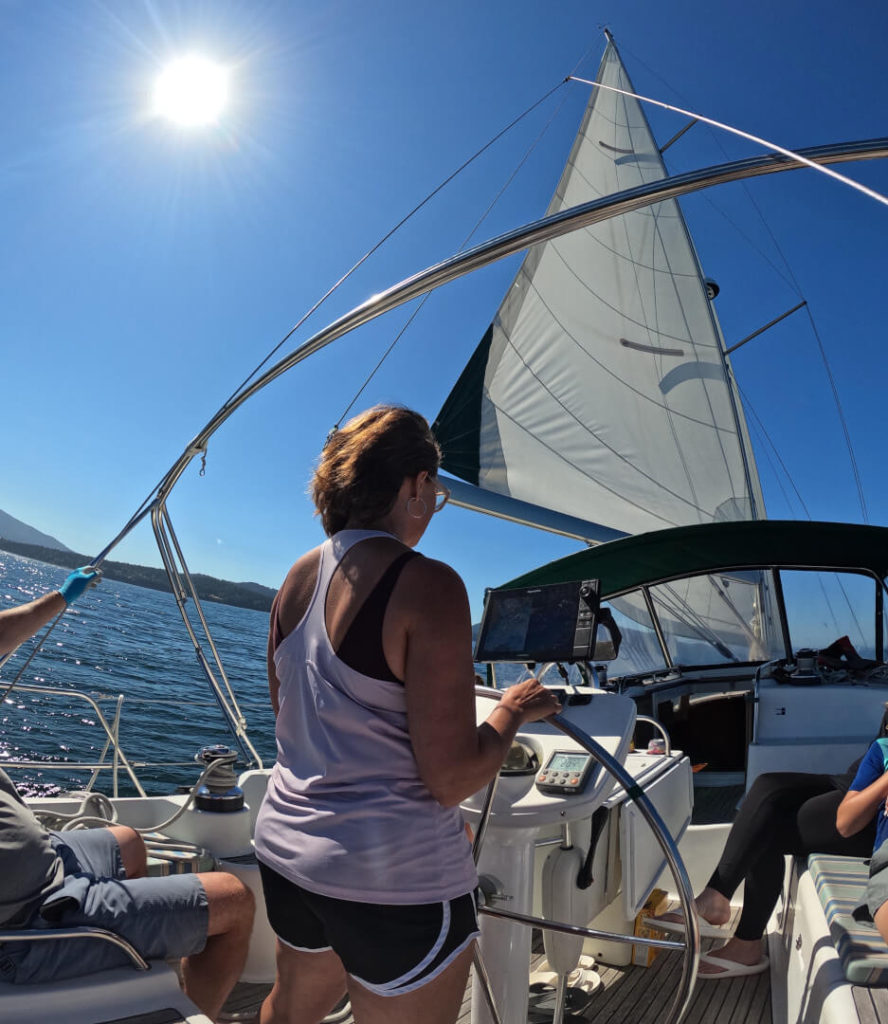
The Jeanneau 43 DS has a fully modern cruising rig that is set up for easy handling by a small crew. Our boat had an in mast furling mainsail and a roller furling genoa/jib. The DS was also offered with a larger conventional mainsail as an option.

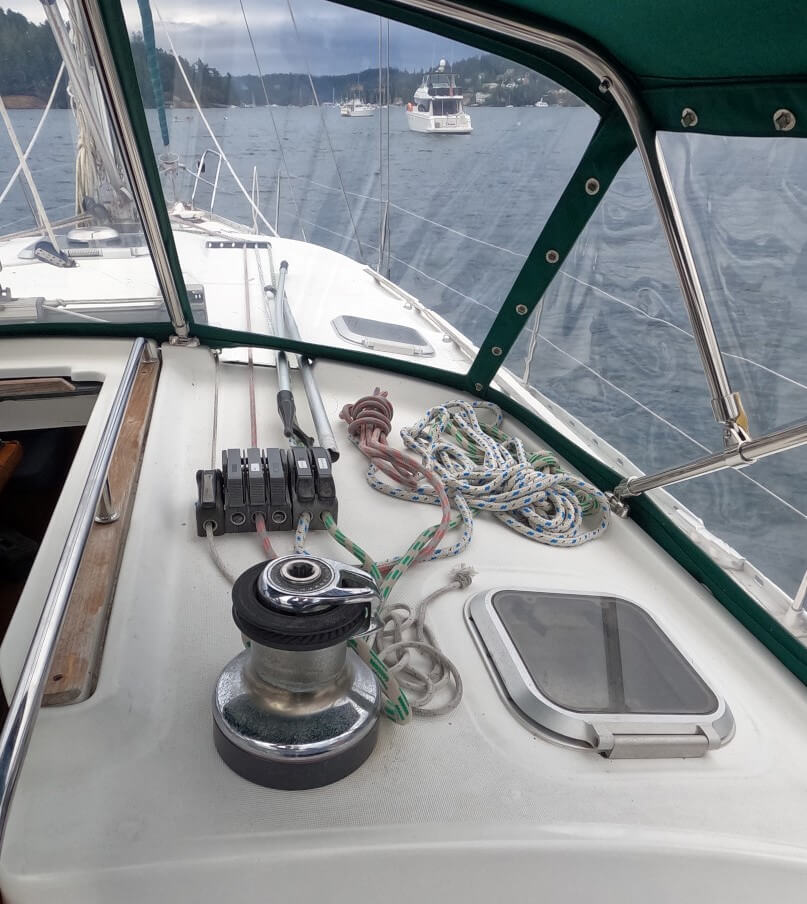

The jib sheets are led toward to self-tailing winches toward the aft (back) of each side of the cockpit where they can be accessed from the helm. The large cockpit makes this quite a stretch, I’m 6′ tall but I don’t think I could do much work on the winch with one hand still on the wheel. All other lines are led to clutches next to winches mounted on either side of the companionway, under the dodger. The labelmaker stickers marking each clutch were mostly peeled off on Cupcake, so we had to follow a few lines up to figure out what was what. The mainsheet, main outhaul (to unfurl the main sail), and both furlers were all led to the port (left) side, so inexperienced sailors like myself can operate the rig without using any of the lines on the starboard side, which were only for sail trim and maintenance.
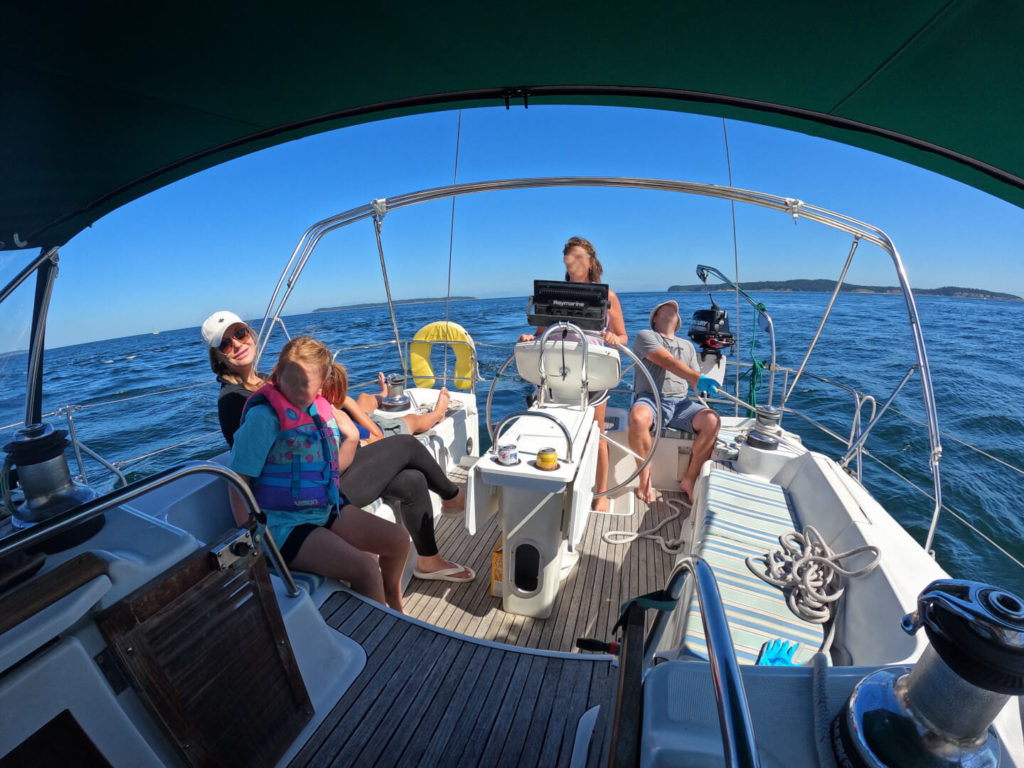
As is usually the case in the San Juan Islands, we didn’t have a whole lot of opportunity to put the sails up because of wind shadows between the islands. However, we got an hour or so of good wind off the beam when rounding the North end of Orcas island. With ? wind we got ? with our amateur ability to trim the sails. While I helped, George sat out and watched the first timers work the helm and the sheets. The boat was very stable, with little heeling.
Docking the Jeanneau 43 DS
This boat is boss at close quarter maneuvering. Our checkout skipper, Mark, took us around the marina to make sure we were comfortable with the boat by directing me into progressively tighter situations. With the wheel hard over and transmission in gear, Cupcake could almost turn in its on length, as if we were using twin engines or a bow thruster. This was not only true in forward, but also in reverse. There was no perceptible prop-walk when starting in either direction. (Read more about prop-walk in my review of the Nordic Tug 26)
While some of this maneuverability surely came from a large rudder, Cupcake was also equipped with a Max Prop feathering prop. A feathering prop has blades that can turn to improve performance: when in neutral, they turn sideways to reduce drag when sailing, When running in reverse, they spin 180 degrees to present the same angle to the water as they would when going forward. This improves reverse efficiency. This is how it reduces prop walk. The improved prop efficiency gets the boat moving more quickly with less of the turbulence that creates prop wash. As a renter, this is such a welcome feature 1) because the unfamiliar boat is more predictable and 2) feathering props are very expensive and require maintenance…for the owner.
Jeanneau 43 DS Galley

In lieu of swinging the companionway steps open, a hatch is cut into the side of the engine compartment that allows for checking oil, but is too low to view the coolant or sea strainer.
Ashore, we think of a galley kitchen as an in-line countertop. However, the “galley” on our charter was L-shaped. This layout makes efficient use of the space for food prep and storage, but is pretty tight for more than one crew member.

Galley Storage
Compared to the 43-foot powercat we chartered earlier this year, the Jeanneau 43 DS galley was very lacking in storage. While we had sufficient room to provision our six person crew for a 5 day charter, it would have been mor challenging to pack for a longer journey with a larger crew.

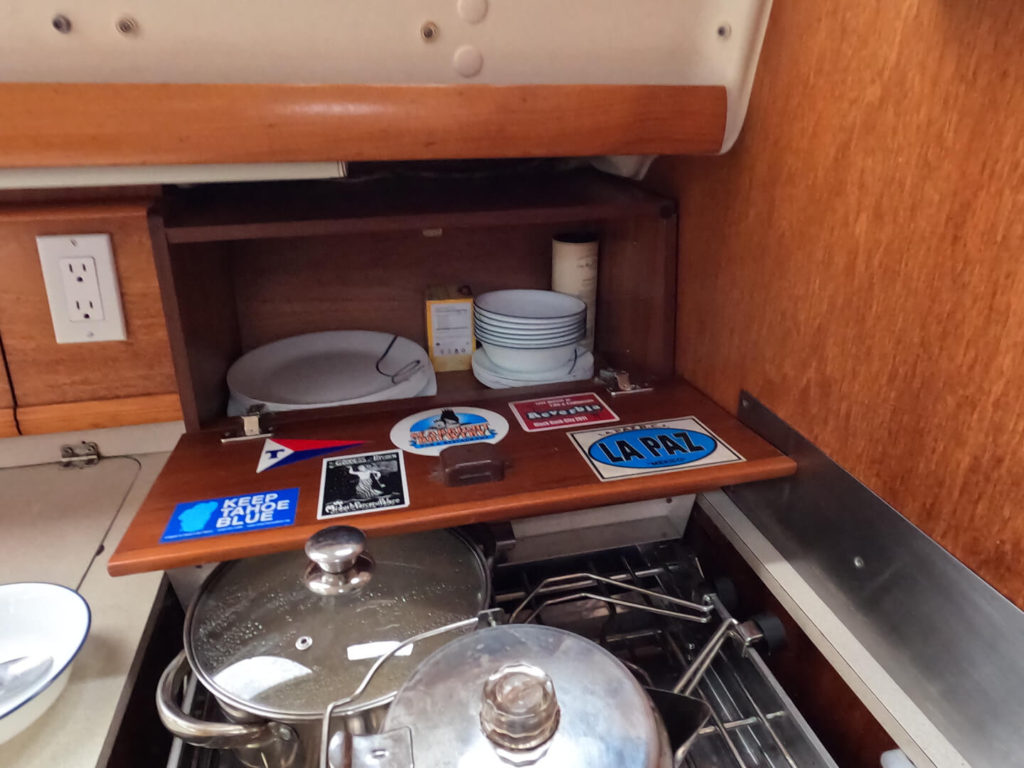
In the galley itself there are four shallow cupboards above the countertops, a spice rack, two bins below the floor and five drawers for utensils. A slight backsplash on the counters forms a lip for the cupboards that helps keep tableware in place. The drawers and floor bins had some handy removable plastic totes to help keep things organized.
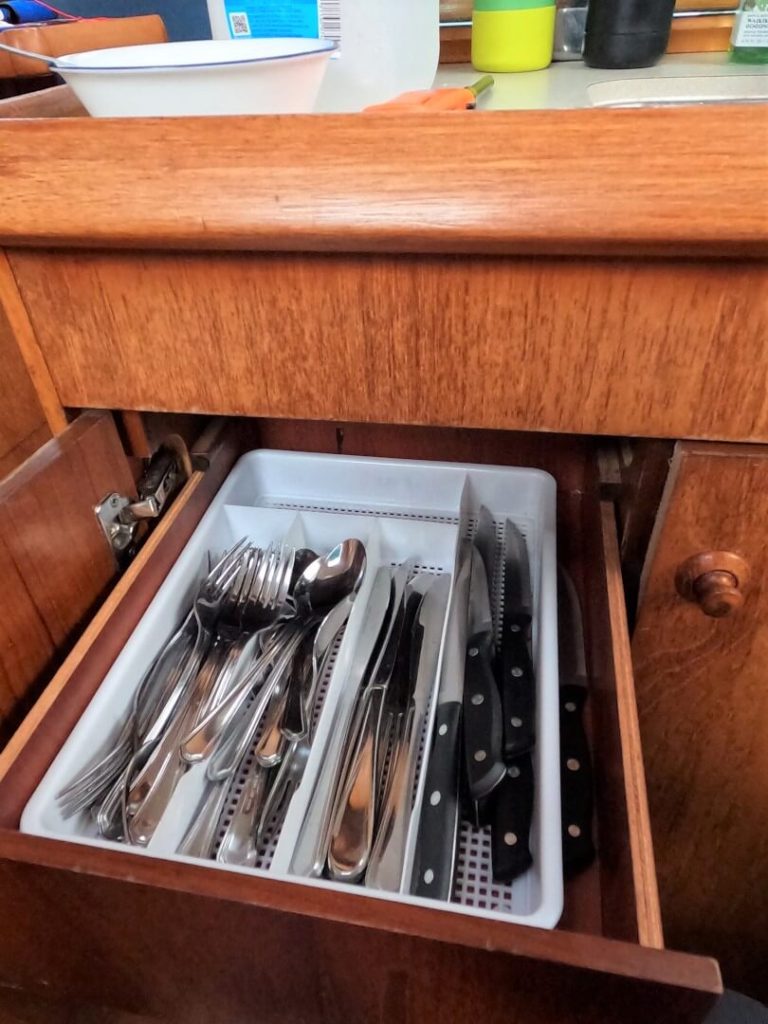


The cabinet below the sink holds a swing out trash can with some extra room for cleaning supplies.
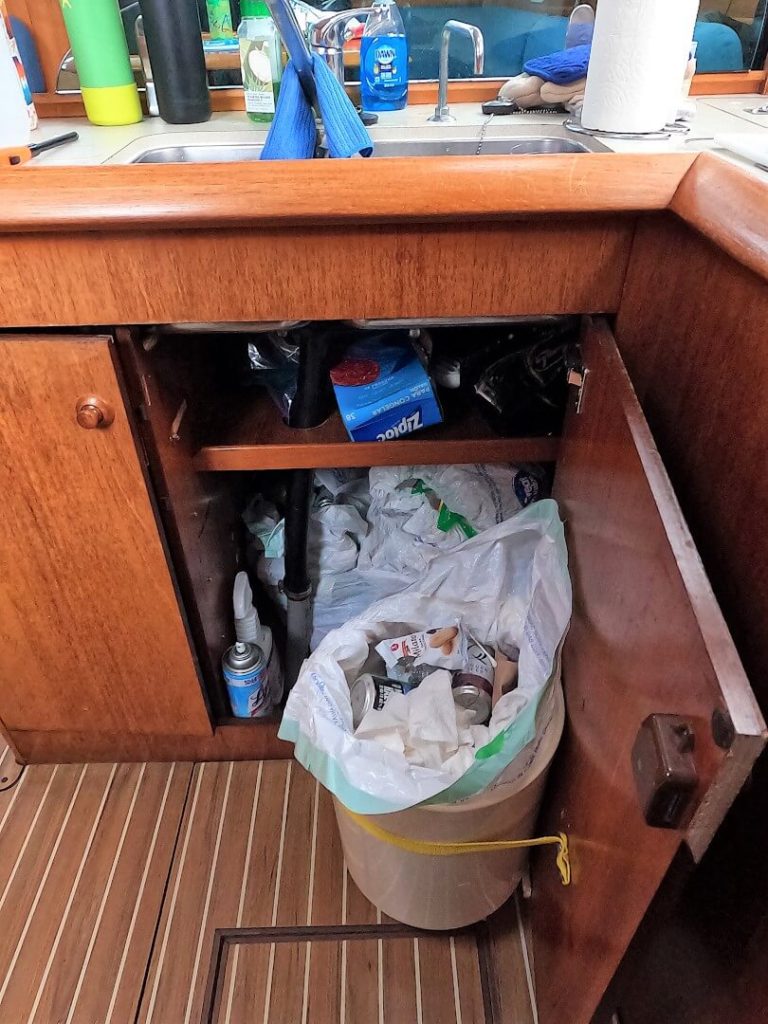
While the galley cupboards were used for dishes, there were additional cupboards behind the settee that we used to store our dry goods. Two cabinets below the salon seating stored the small appliances and cookware.
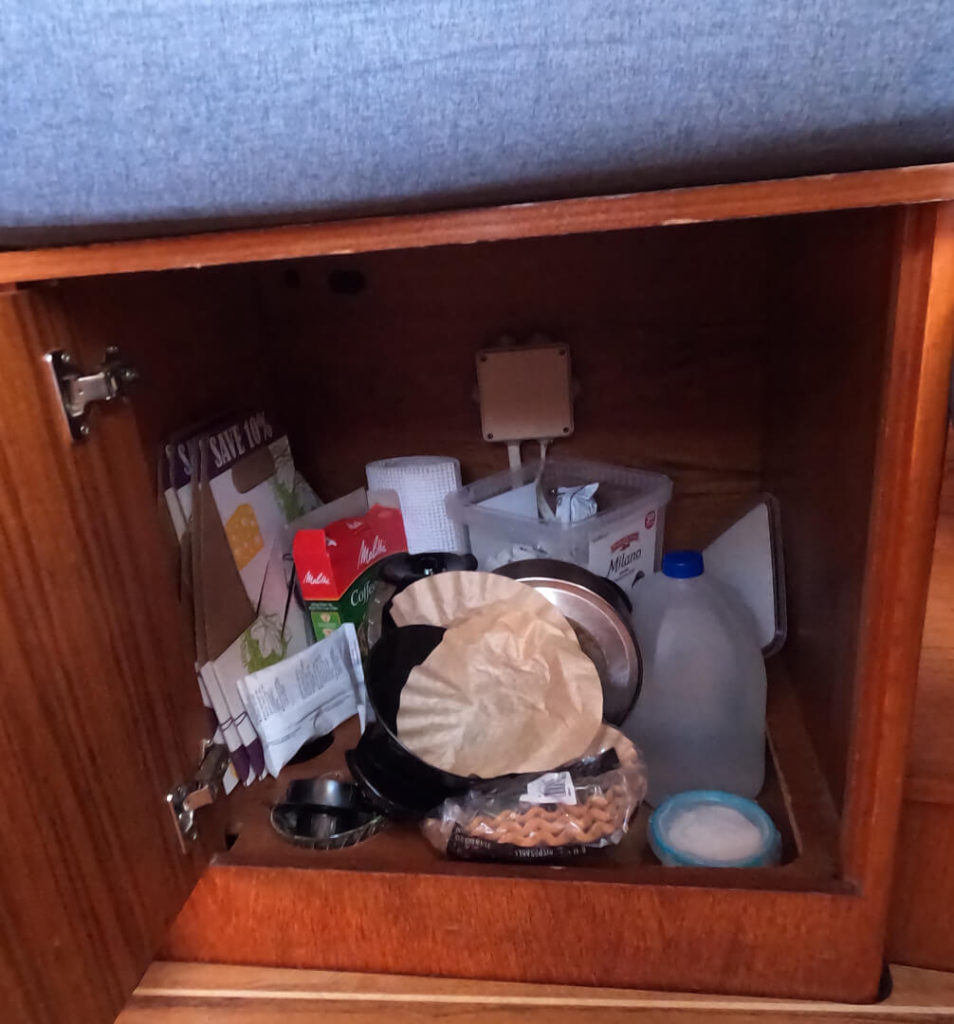
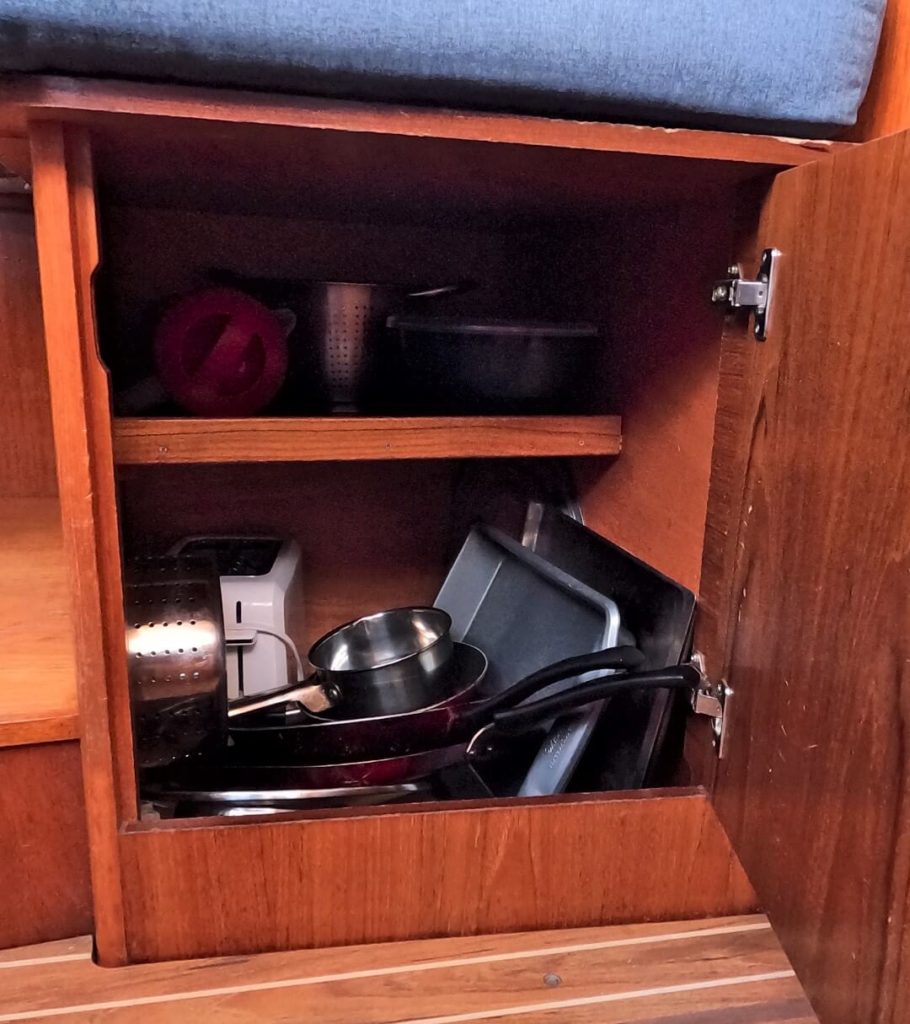
Galley Appliances
Range
Our boat was equipped with a three burner propane stove and oven. It is mounted on a gimbal so keep level while sailing, but we left it locked since we always cooked at anchor. It also has rails that can hold pot restraints, which we used to keep our hot coffee in place while underway. The three burners on the stove are each a different size. I used the largest to get my water boiling quickly, then moved my pots to the smaller burners to keep them warm without scorching the pans or adding more heat to the cabin than necessary.
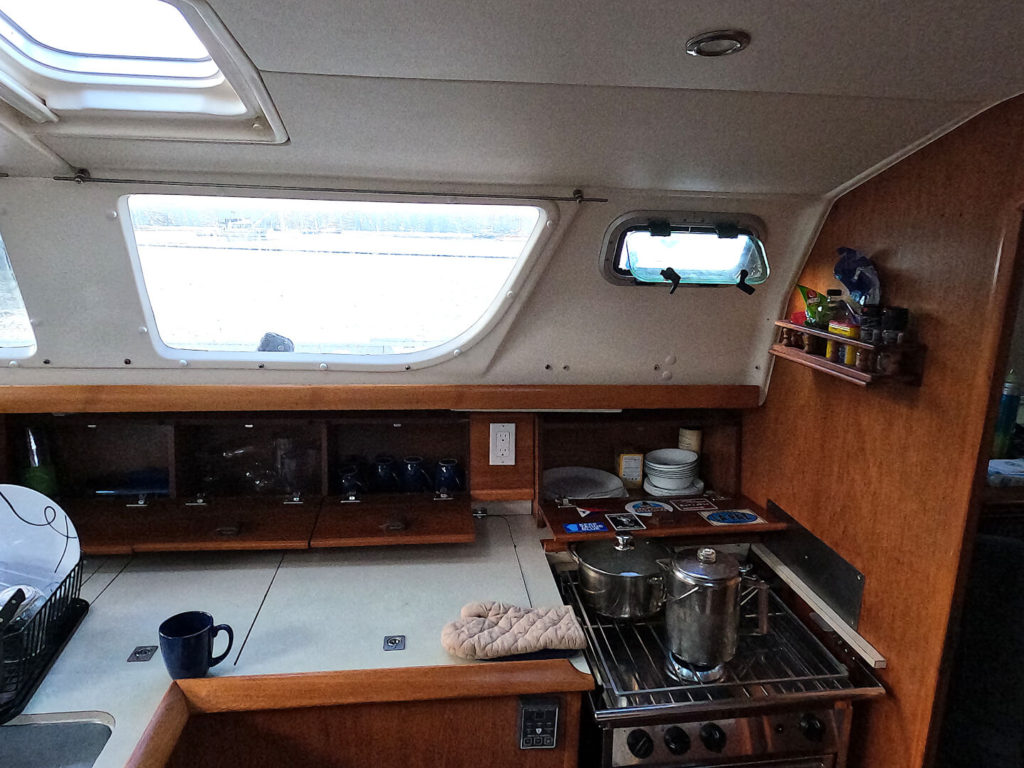
A port is mounted just above the range that should be open while using the range to allow for safe venitlation (and a bit of cooling). Since propane leaks can be very dangerous in boats, a combination propane valve and propane sniffer is mounted next to the range. The propane tanks are located under the rearmost starboard (right) seat in the cockpit. You can’t open the hatch with a cushion installed, so that was a bit of a pain since I always close my tanks when not in use to ensure no propane leaks into the boat.
Refrigerator

While dry storage wasn’t great on this boat, the refrigerator was absolutely huge. The cold plate, mounted up front was incredibly effective. We were told to run the thermostat at 3-4, but froze a few soda cans at 3 and turned it to 2 after the first day. Despite the fridge being only 1/3 full, turning it off at night, and my crew opening it constantly for beverages, our bag of ice was still half full after four days.
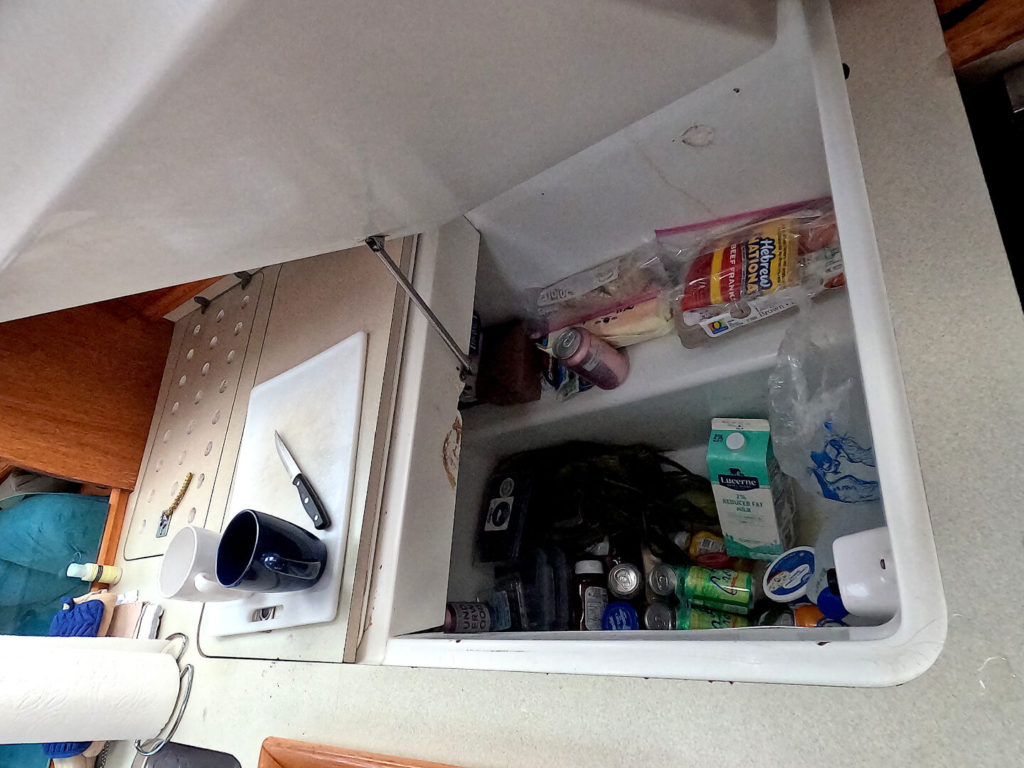
While some Jeanneau 43 DS refrigerators load from the top and the front, this model was strictly a top loader. A ledge built into the rear helped keep things organized and uncrushed in the deep cooler. We put soft, small, open things that needed to stay dry up here. With the top hatch split into two pieces, we put the coldest, least needed items in the back, under the second hatch. The hatches have a spring that holds them open while you are digging around. Great feature for responsible crews, but I found that some people would leave it open too long and LET THE COLD AIR OUT.
There was no freezer in this boat, but we were able to keep a bag of ice for drinks in the refer for three days…despite the frequently open hatch and turning the compressor off at night.
Behind the refer, there was a drained, vented bin that we used to store fresh produce with a few cold sodas to keep the bin cool. This would be a great spot to squeeze an extra day or two out of your fruit and veggies in warmer climates.
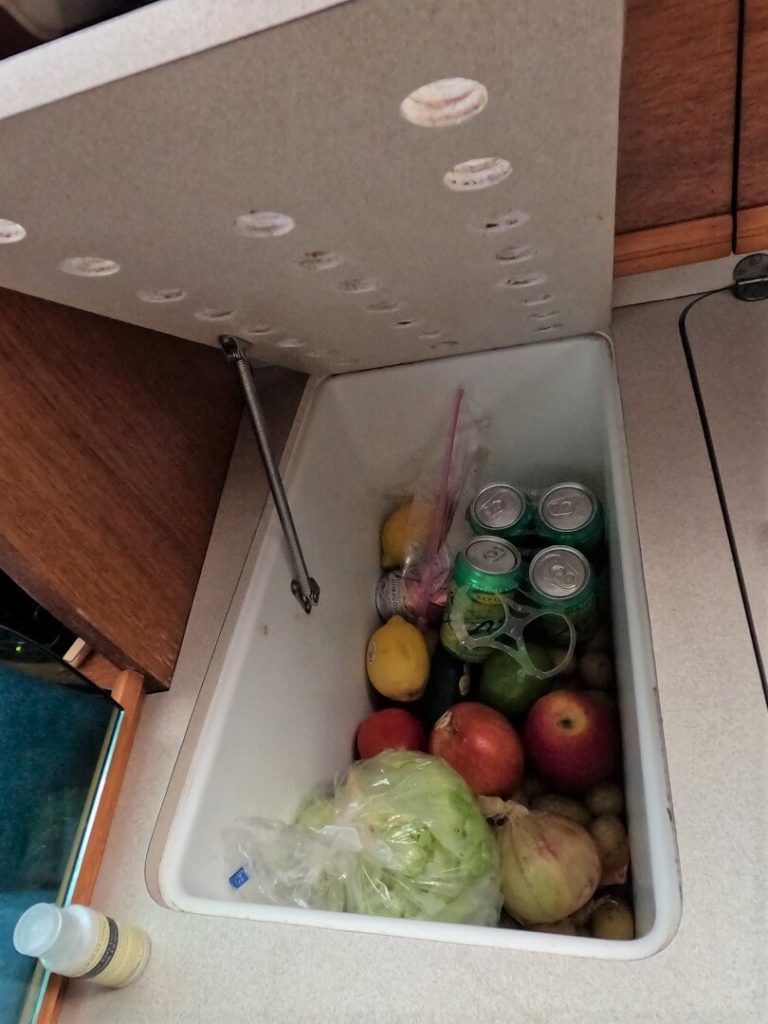
Jeanneau 43 DS Cockpit

The cockpit has lots of room for an upright crew with all of the sailing gear set out of the way for comfortable cruising. The boom is mounted high above your head, even when standing. The four winches are mounted at the four corners of the cockpit. The mainsail traveler is mounted on the coachroof, in front of the dodger. To keep the backstay out of the way, it it split in two, attached at the corners of the cockpit. Unfortunately, the seats offered only a low sloping back. So my crew preferred to lay sideways against the bulkhead most of the time, making it feel a bit more crowded.
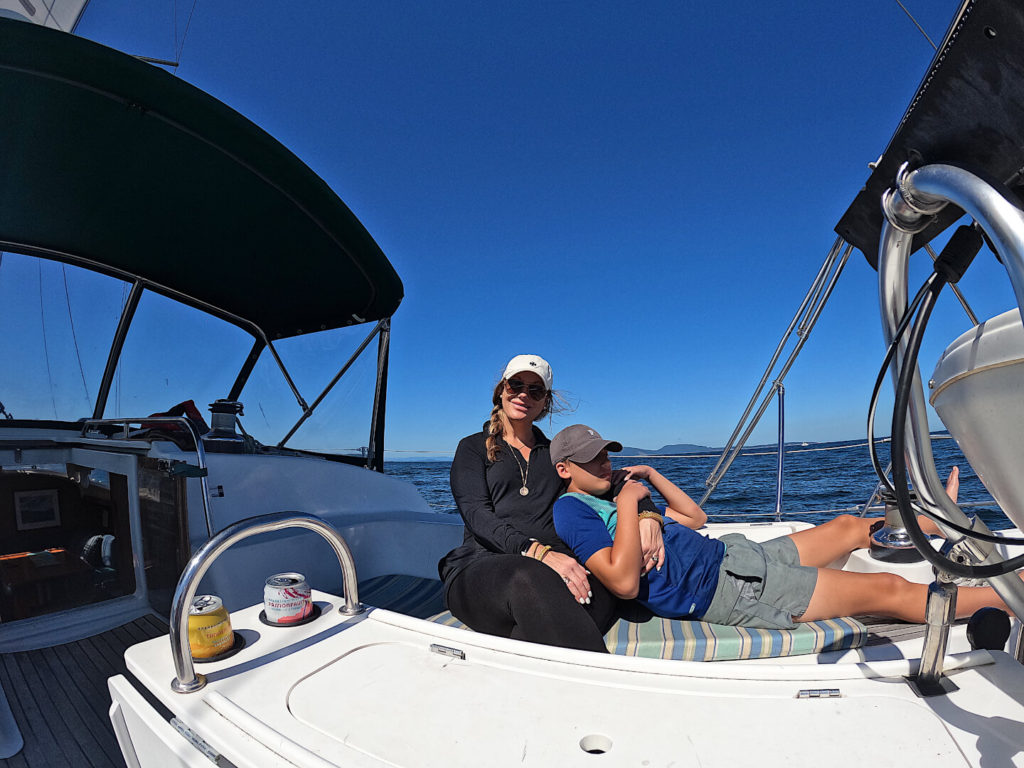
The folding table in the center of the cokpit had two cupholders and a deep storage bin on the narrow section that remained when the table was folded. This gave us quite a bit of function without needing to block the walkway with room to set beverages and phones while keeping things like binoculars and water bottles handy in the bin below.
Just as we saw down below, steps are plentiful out here in the cockpit too. There’s a big step up at the forward end of the cokpit before going down the companionway steps to the cabin. There’s a little step down in front of the helm. The steps down to the transom interrupt the cockpit seating. And to climb forward out of the cockpit, you need to step onto the seat, then over the back and down to the walkway…make sure you’ve got a firm hold of something throughout this maneuver.
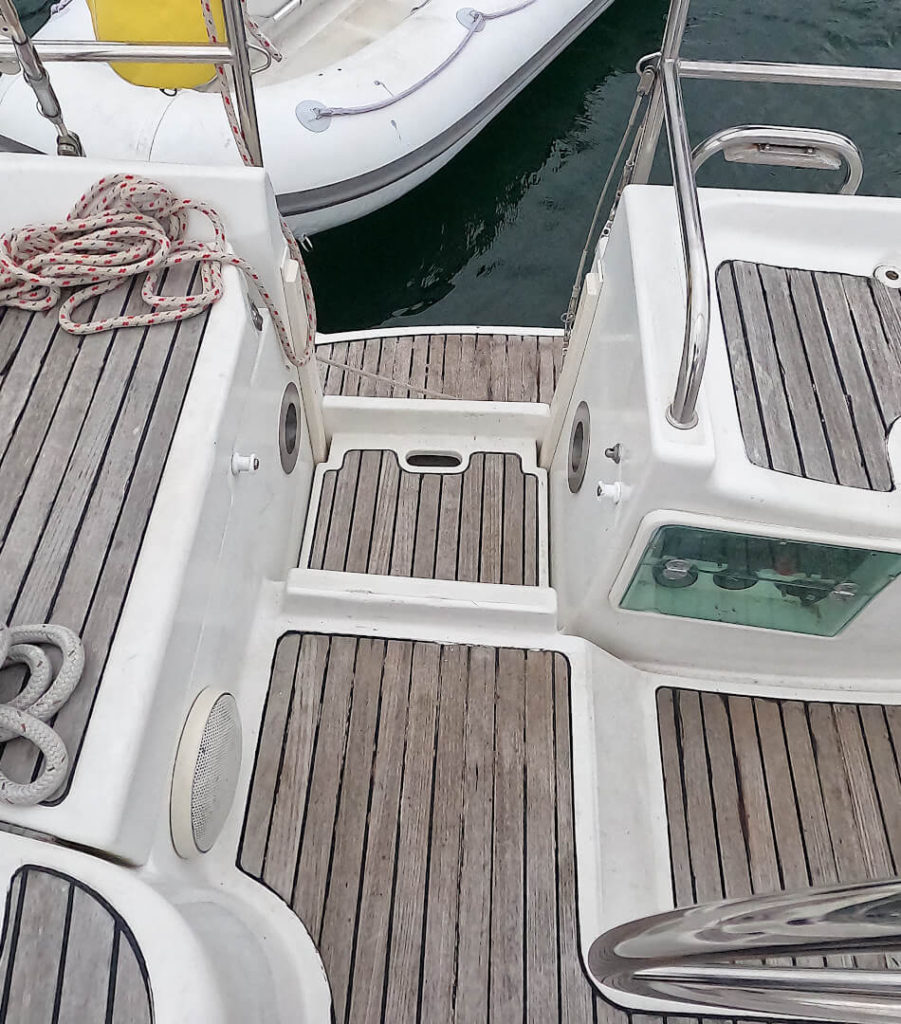
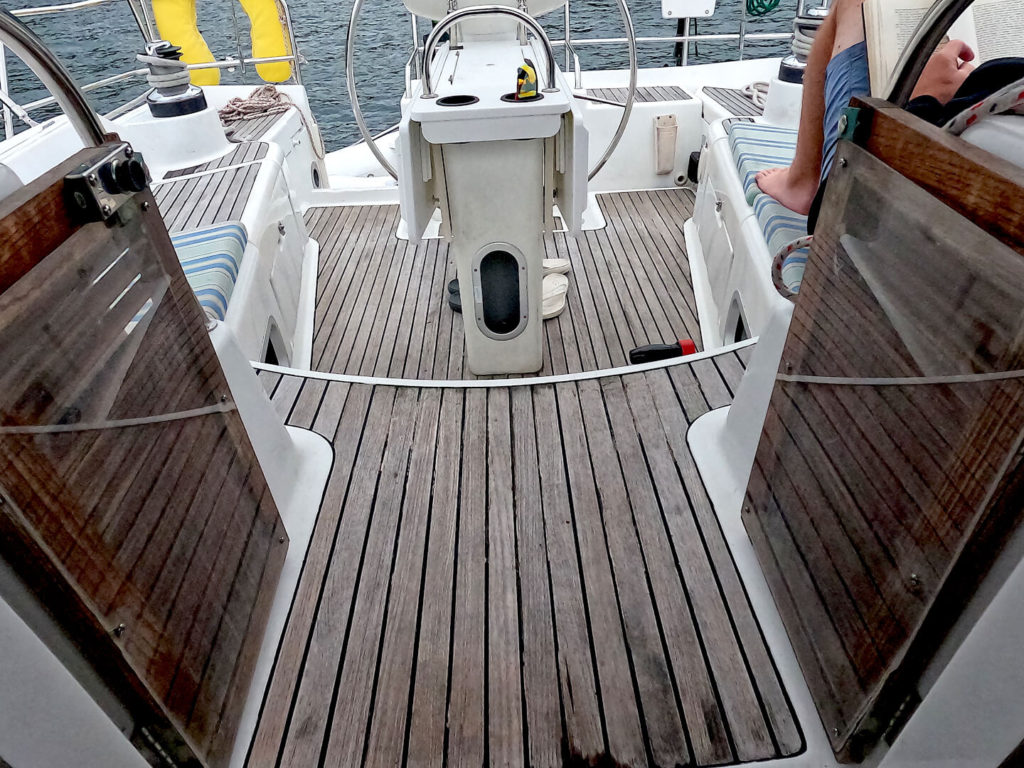
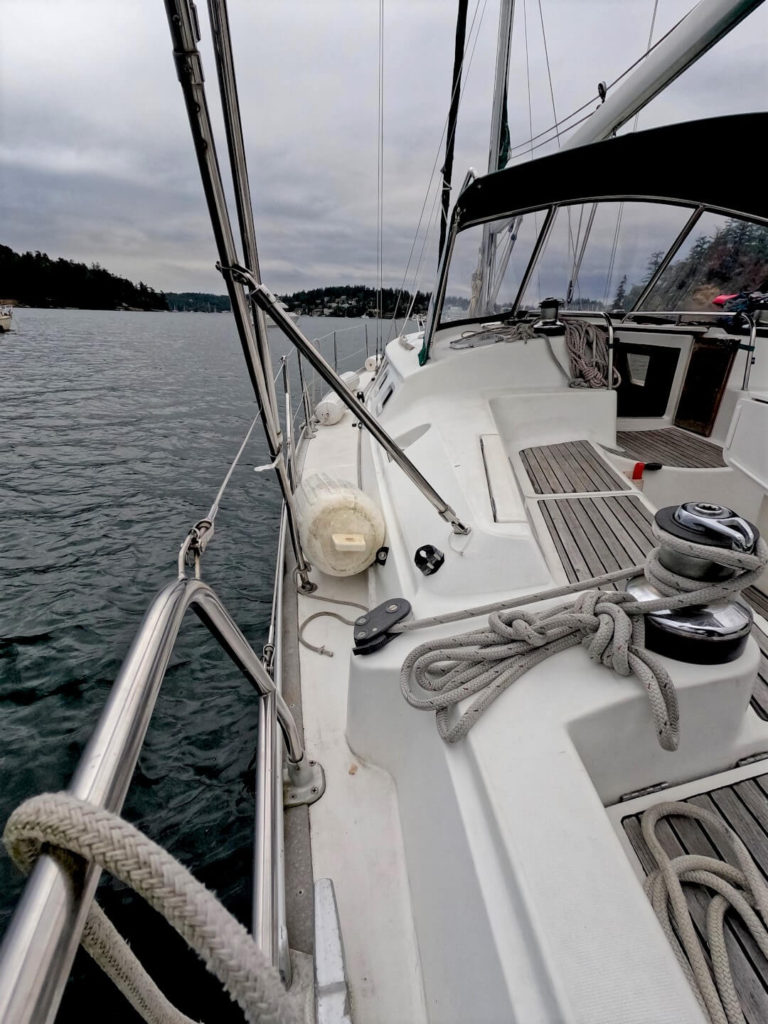
The cockpit seats are hinged above the back, allowing very generous access to storage. Our storage was quite full with the barbecue, spare lines, and dinghy pump on one side and crab pot on the other.
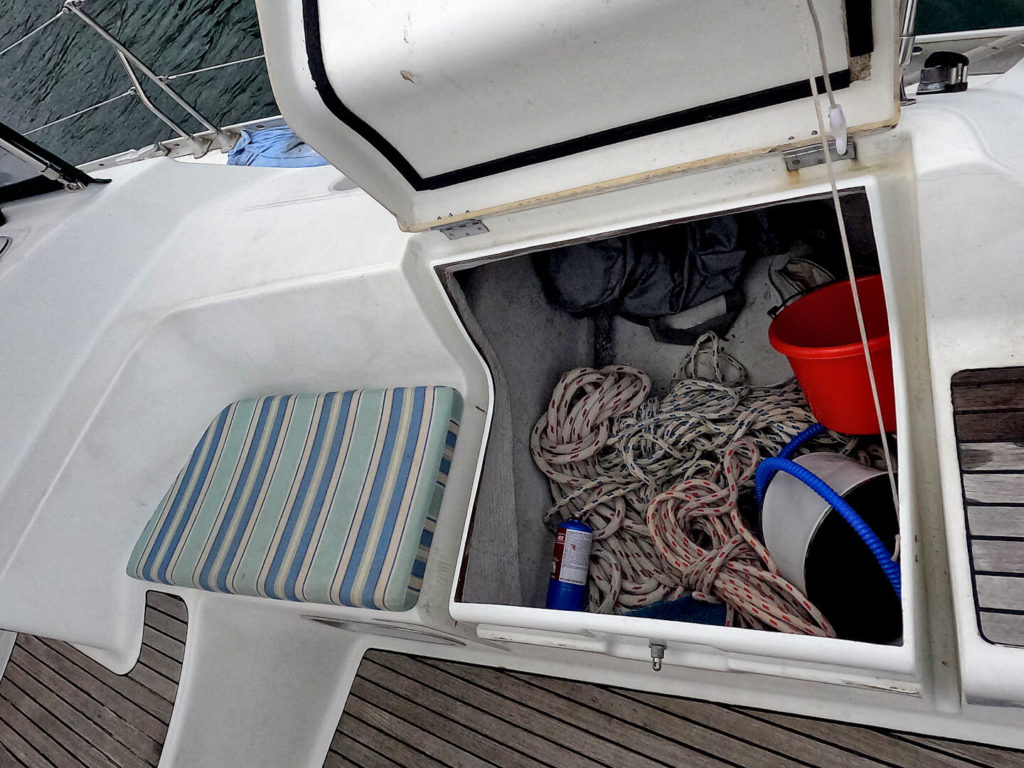
At the transom, you’ll fine the shore power receptacle to port, a swim ladder in the center, and a freshwater washdown sprayer to starboard. This is all mounted above an ample swim platform that makes it very easy to board the dinghy.

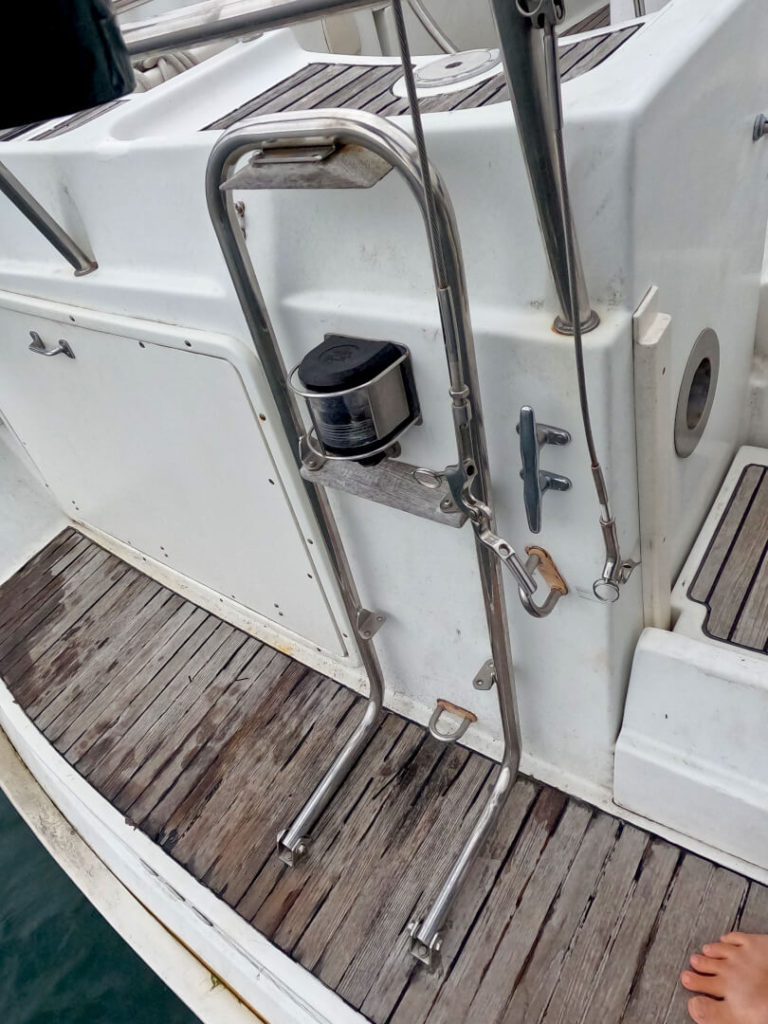
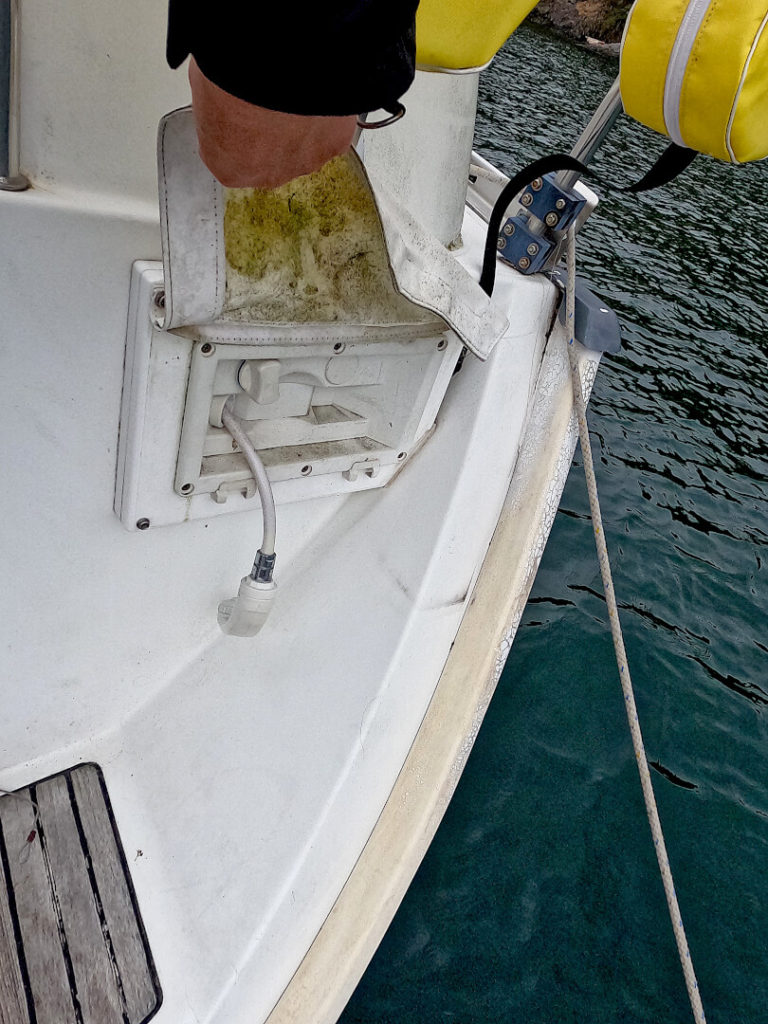
Side Decks

With the lines led to the cockpit, we only needed to use the side decks to get to the anchor. They were somewhat narrow with relatively low lifelines. As long as I stayed low, I felt very secure moving between the lifelines, a teak railing on the coach roof, and the mast stays.
Dinghy Management
Cupcake is equipped with a davit and mount above the transom to raise, lower, and store the outboard motor for the dinghy. This was a very handy way to manage the motor without dropping it in the ocean or breaking stuff trying to muscle it around. We towed the dinghy from an eye on the swim platform that was mounted just off the centerline of the boat…making the dinghy fight us a bit while under way. A longer two rope would probably have helped with this.
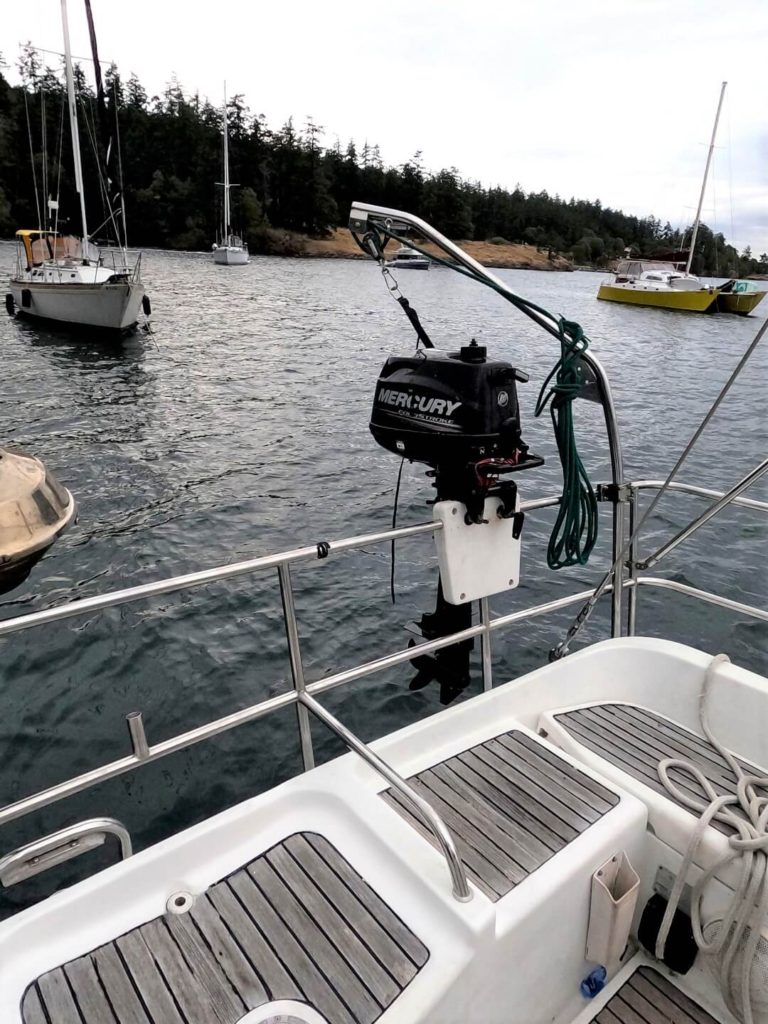
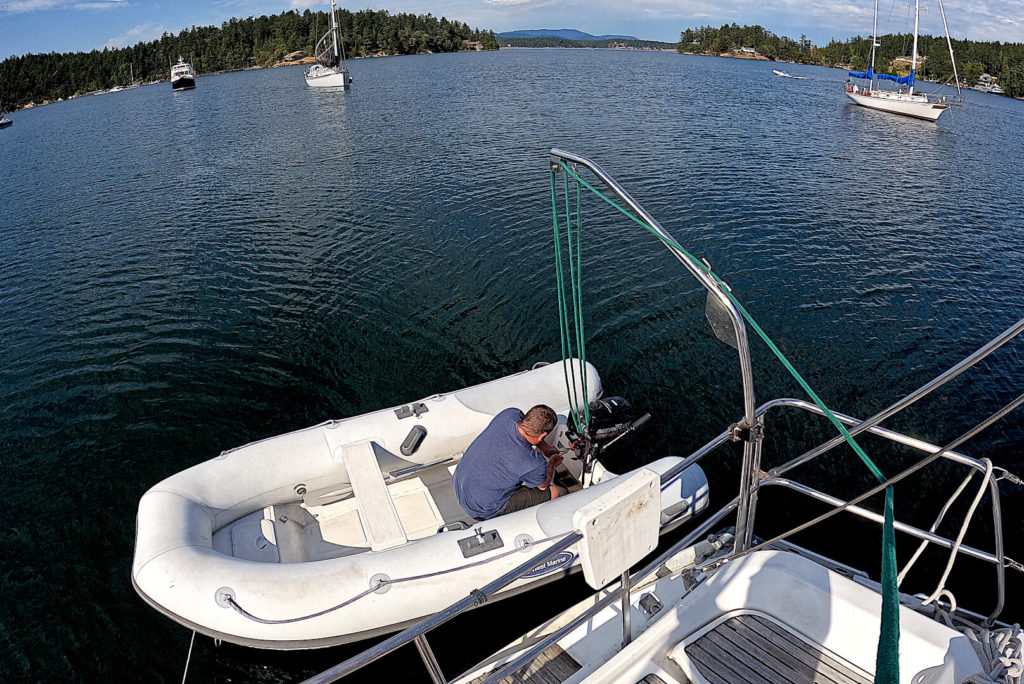

Jeanneau 43 DS Saloon

The saloon or salon is what sets this boat apart. I can stand comfortably here as a six-footer here. The windows let lots of light in. When standing up, you’ve got a fantastic view outside…relative to other sailing monohulls, anyway. However, when sitting down, the windows are too high to see much.
This boat uses a lot of steps to make the headroom work while also taking full advantage of its beam (width). The tables and benches are raised above the floor, allowing them to be set as far outward as possible, above the tapering hull. While the floor sits lower to maximize headroom. At the forward end there are two steps down toward the stateroom, again to improve headroom. The downside of all these steps is you’ve got plenty of opportunity to trip, stub toes, twist ankles, and tumble when moving quickly.
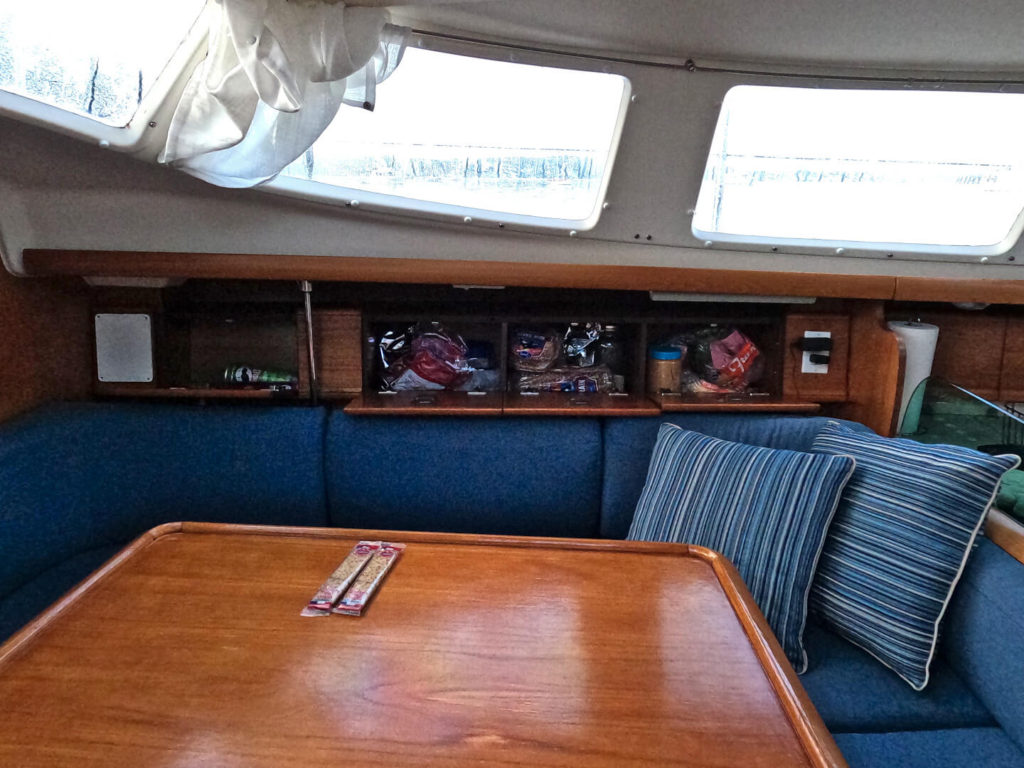
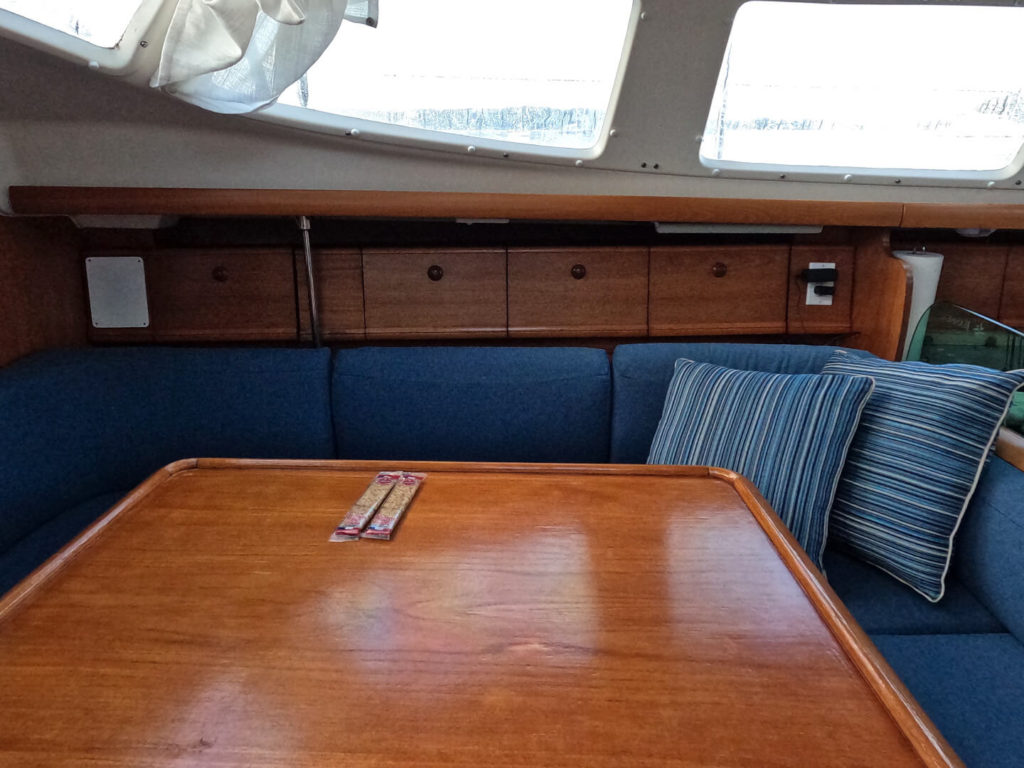
Behind the settee, you’ll find a set of cupboards that can swallow a surprising amount of provisions. Below the settee, there is drop in storage to the left, tankage in the center, and a front opening cabinet to the right.
Opposite the settee, you’ll find a very generous nav station. Seats on both sides make it easy to plan as a team. They also provide some additional seating for dinner or games near the settee. At one end, there storage for charts and books. The VHF and stereo are mounted in the center. Electrical panels are mounted at the opposite end with a little bin that’s great for storing binoculars, radios, and such. Below the table, you’ll find the water systems mounted against the hull. The table leg itself has a clever storage area for additional navigation aids.

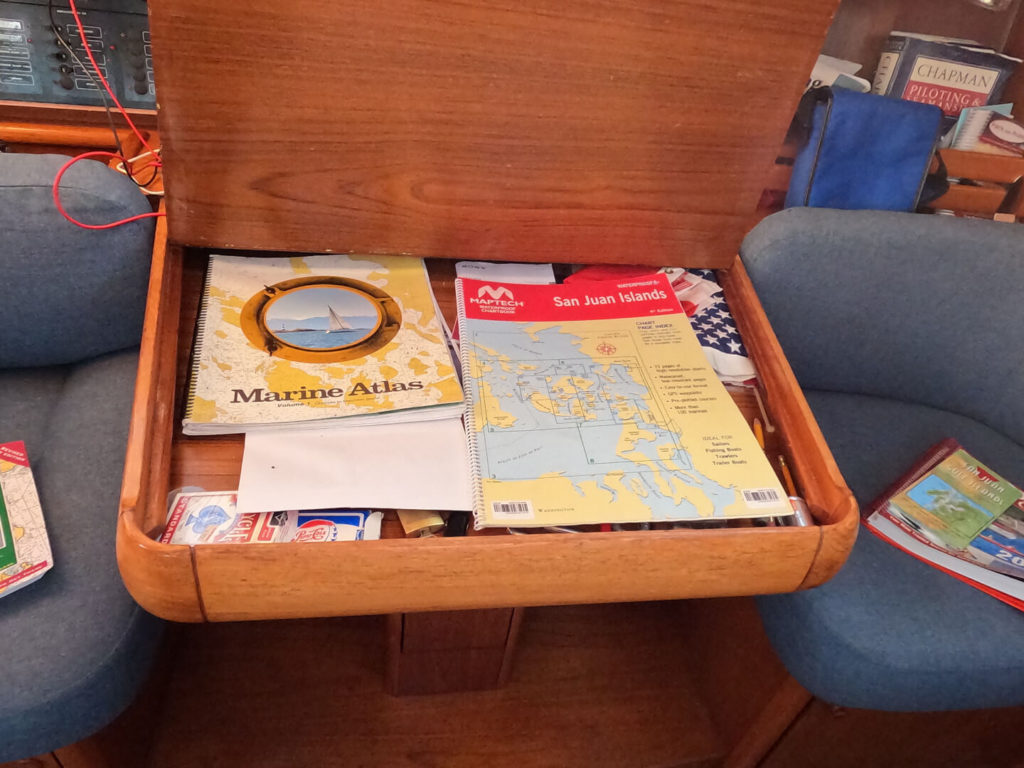

Jeanneau 43 DS Staterooms
Our charter boat had a three stateroom layout with room for two in each of two staterooms at the stern and a forward stateroom with a v-berth for two behind two single bunks. This facilitates sleeping for a crew of 8 without converting the settee to a bed.
Forward Stateroom
The forward stateroom is actually the reason we chose to charter this boat. With four berths in a single room, its great for small children that don’t like sleeping alone. In fact, with the en suite head, this single stateroom offers more accommodations than the entirety of some 30 footers.
Headroom is very generous here, accommodated by two steps down in the saloon ahead of the stateroom door.

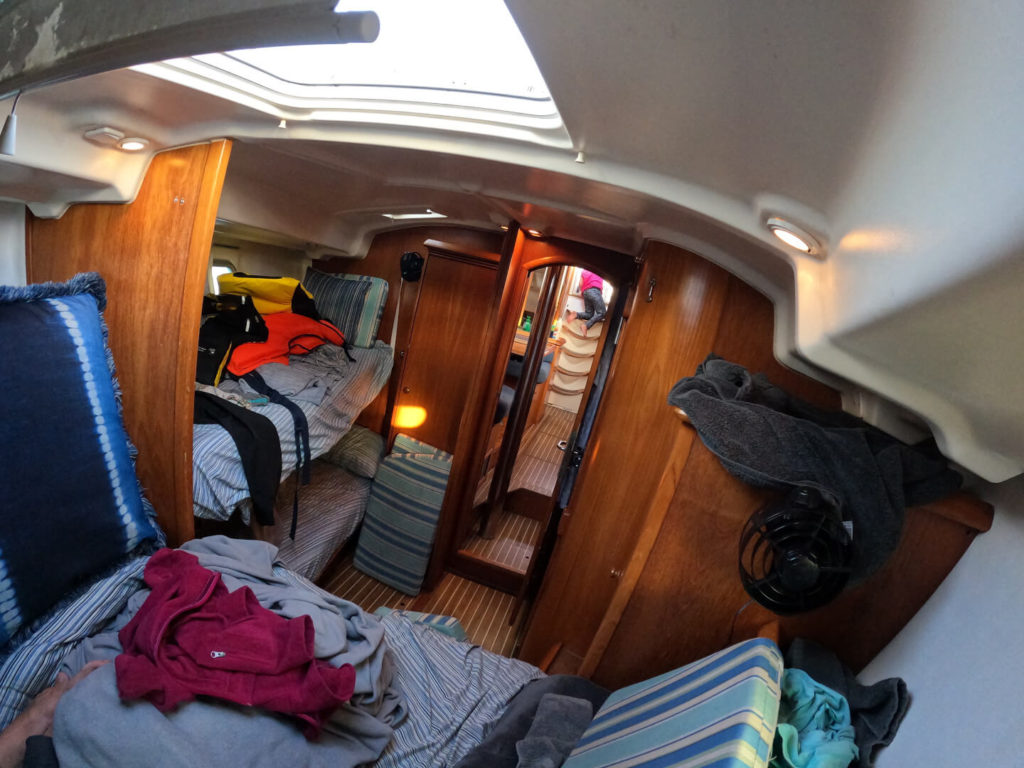
The forward v-berth is actually very generous, over 7 feet deep. However, even in person, it doesn’t appear as large as it actually is. This meant our planned sleeping arrangements did not stick: some of our crew insisted it was too small despite it being roomier than the berths in the aft staterooms, just a bit tighter at the foot. It was also mounted pretty high, requiring a bit of climbing to get in.
There’s a large hatch above the V-Berth. The remote for the anchor windlass plugs in above the V-berth and extends through the hatch. So when choosing sleeping accommodations, know that crew will be climbing on this berth when anchoring. And if you’ve got kids in here, consider unplugging and removing the remote when not in use. There are three ports in this cabin to let some additional light in, but they do not open. In fact, none of the hatches below the top deck can be opened in this boat.
The bunk beds were tapered, with the widest part toward the stern, behind the closet. Using this end as the head gives you access to the reading light. George chose to do the opposite, sleeping with his head at the narrow end. He fell out of the top bunk in the middle of the night.
With two separate haging lockers, storage is ample. There are also a few small bins hidden in the floors and crannies for additional storage. Some flat surfaces run the length of both sides of the v-berth, in addition to flat surface atop both hanging lockers.
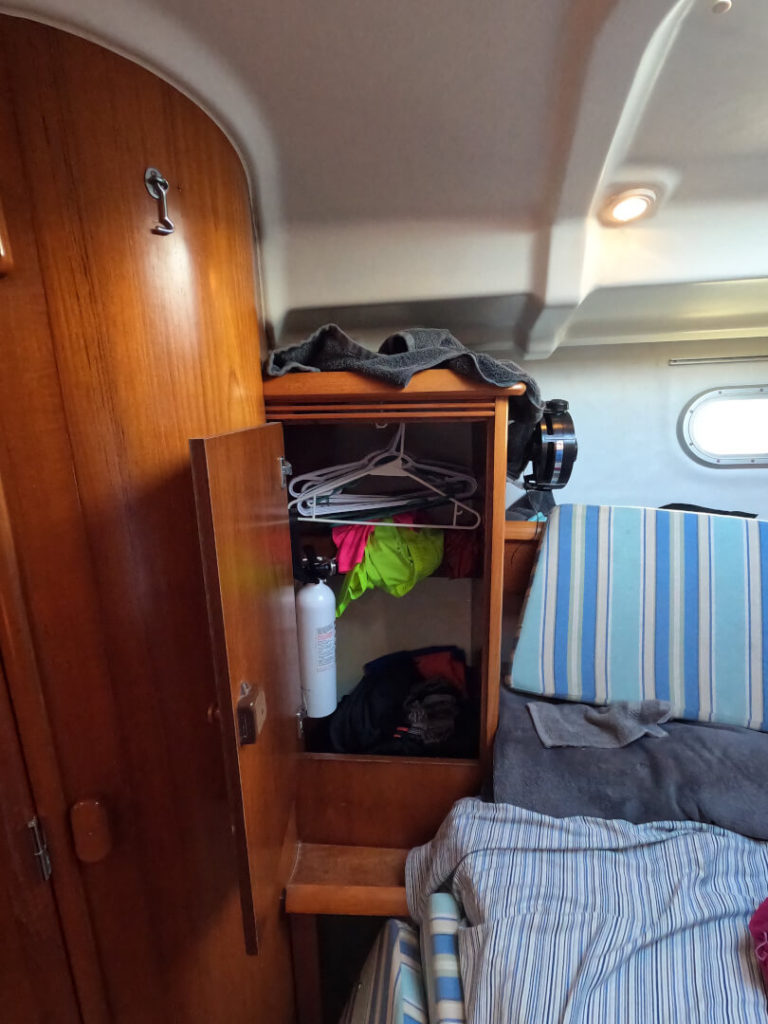
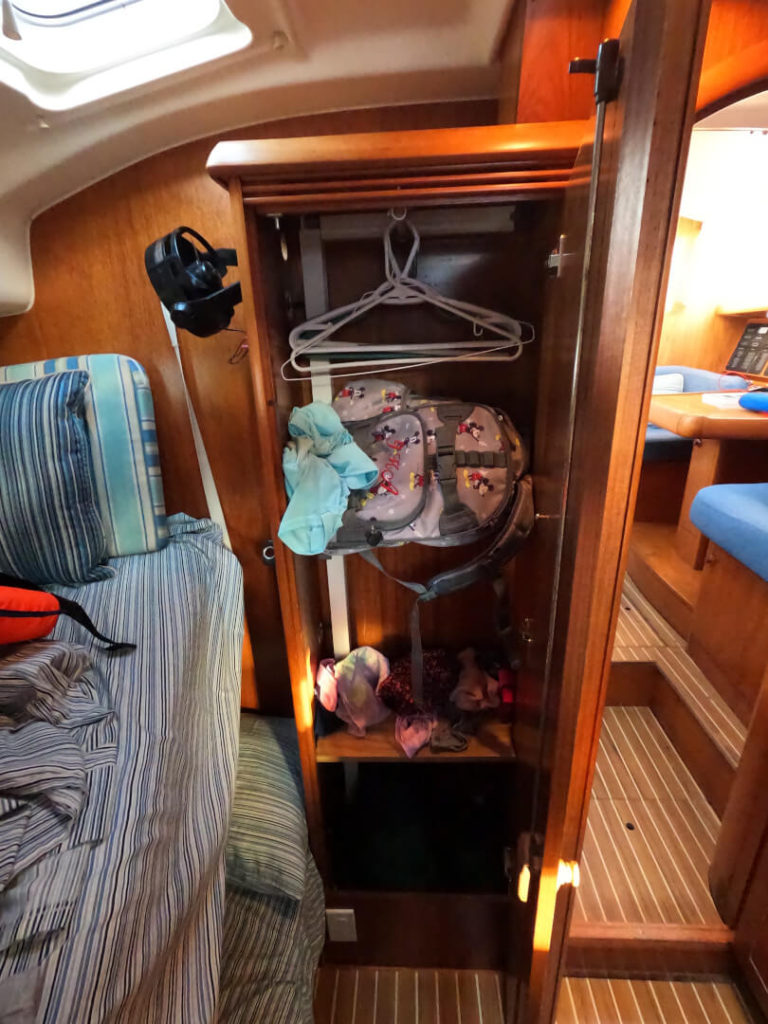
Aft Staterooms
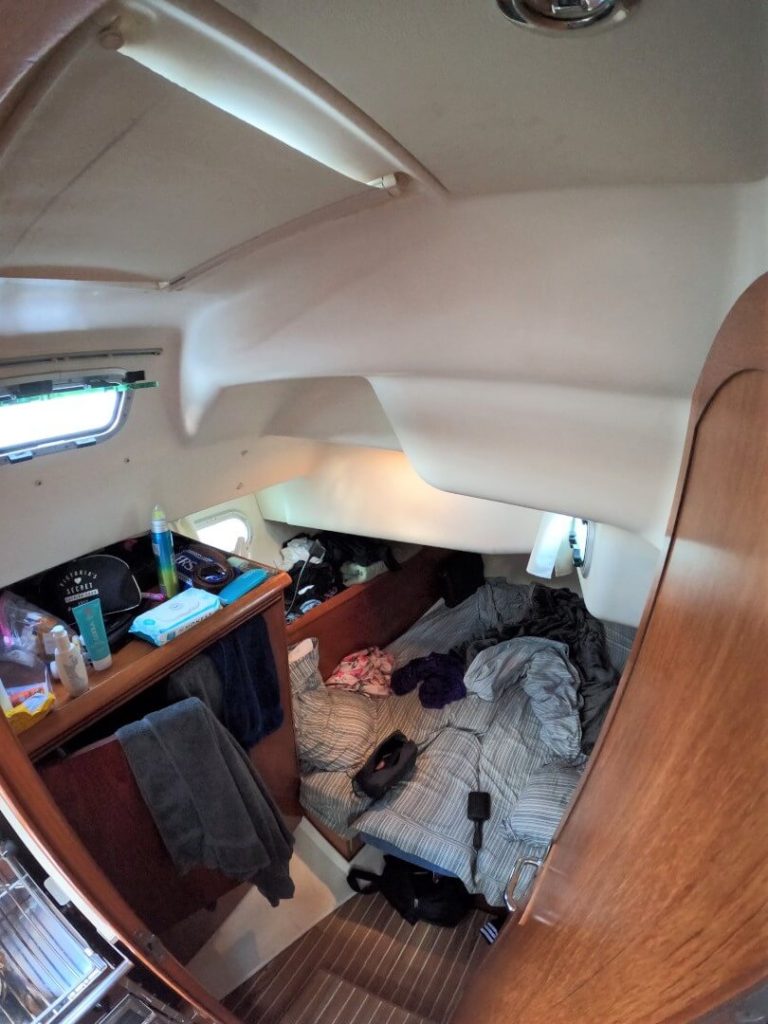

The two aft staterooms are mirror images of each other with two important differences. The port (left) stateroom has a dedicated door into the aft head as well as access to the master battery switches and the windlass circuit breaker. Because of the electrical controls, consider putting the skipper on the port side.
Each stateroom has one sealed port, two opening ports, and an opening hatch. Note that one of the ports opens into the cockpit and the hatch opens under the dodger, next to the sailing rigging. This can be a concern if you are going to bed before the rest of the crew, but the dodger protects an open hatch from the rain.
Storage in these staterooms is ample. A large cabinet to the outside is divided in half, with one side as a hanging locker, and the other set with shelving. Another small cabinet is built into the floor behind the cabin door. This small cabinet has a lot of dead space above it. There’s lots of flat surfaces to set things with a sill running along the berth and room atop both cabinets. There’s also some storage on the floor beneath the berth.
Two steps down into the stateroom allow for plenty of standing room ahead of the berth. The ceiling progresses downward as you move toward the foot of the berth. The berth itself was plenty roomy at both ends with a slight taper toward the foot. I’d say it was almost as wide as a queen at the head and almost as wide as a full at the foot. There’s a removal v-section at the head with storage space below. Why you’d want to remove that section, I don’t know. The berths were very low, making them easy to climb into and use as a bench when putting on your shoes.
Jeanneau 43 DS Heads (bathrooms)
Aft Head
The aft head is the larger of the two heads. It has a separate shower stall and lots of light through two hatches, a port, and a large ‘Deck Saloon’ window. Probably 90% of all ‘business’ was conducted in the aft head on our charter. This can be an issue on the 43 DS: there are separate holding tanks for each head, and they can overflow when overfilled…and they do not have tank monitors. If you are going to be on the water for several days, be sure your crew is making good use of the forward head so you don’t overfill the stern holding tank.


The aft head opens into the salon as well as the stateroom behind it. Be sure to lock both doors if you aren’t a showman.
While the cabinet under the sink is reserved for plumbing, there is good storage in a cabinet behind the head as well as on a ledge above the sink.
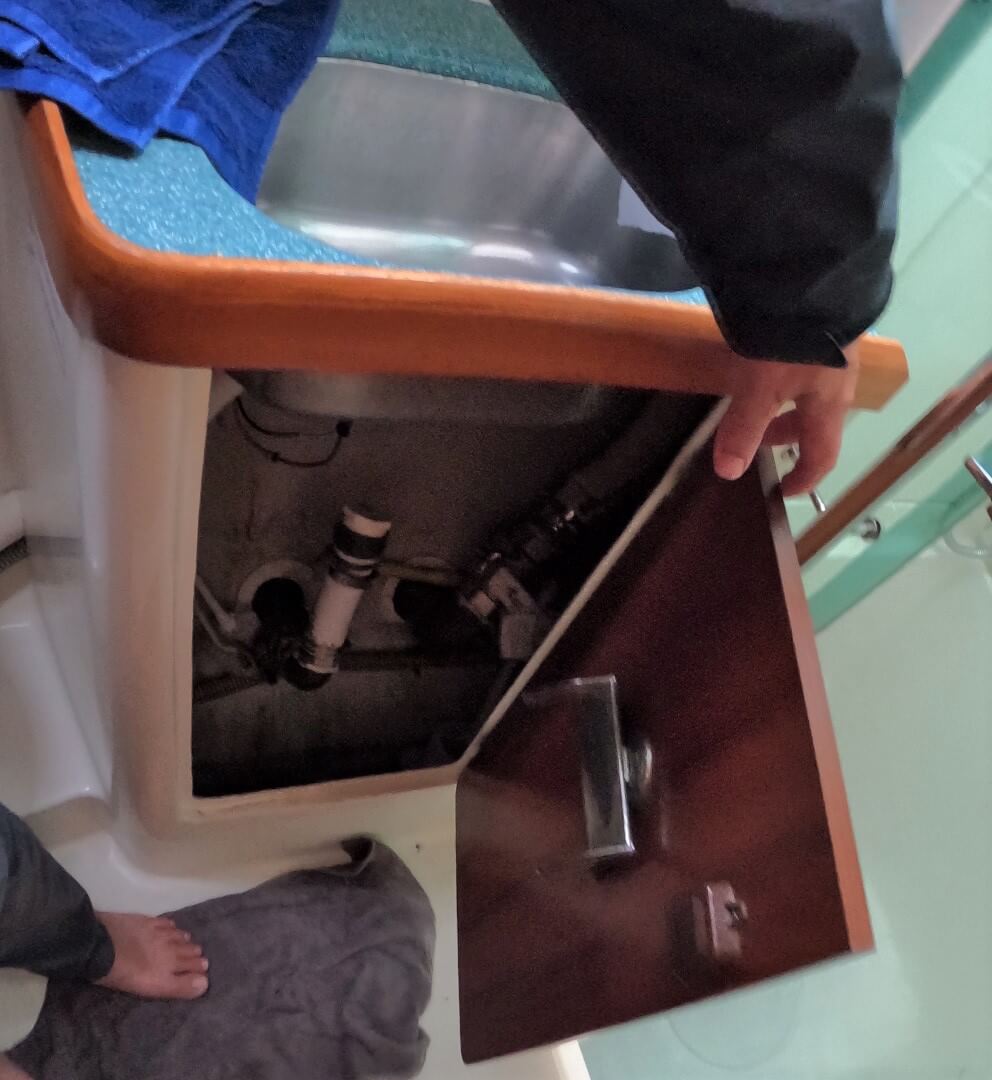
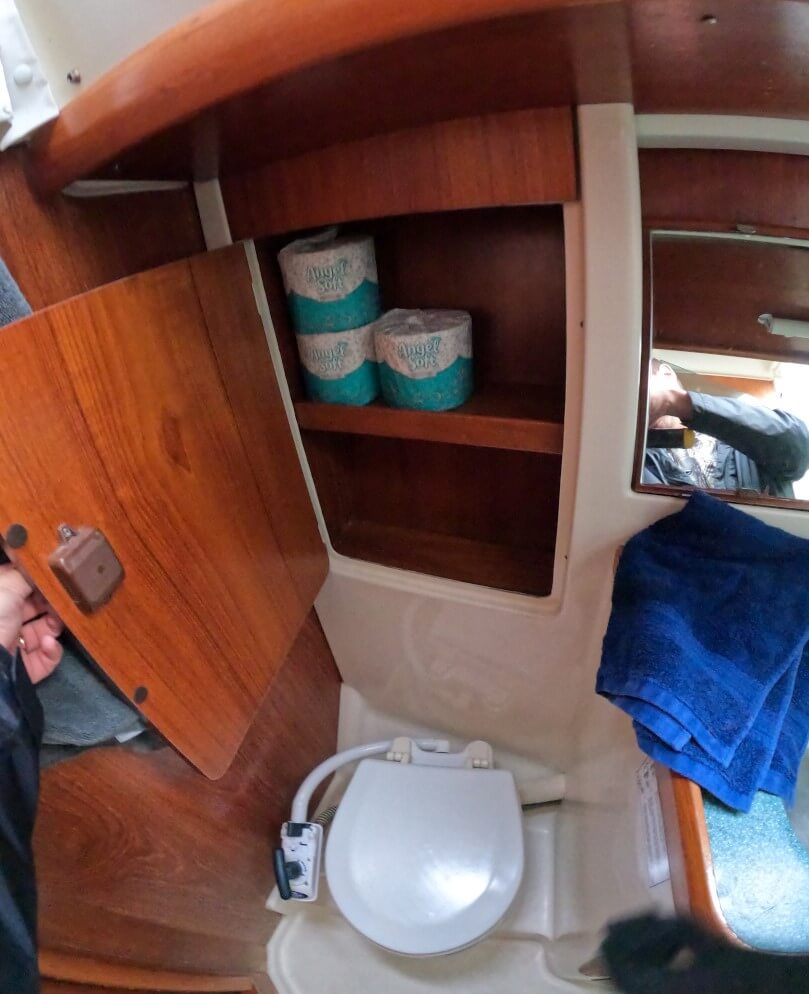
Forward Head
The forward head is entirely inside the forward stateroom. It is much smaller, with sunlight and fresh air coming from a single overhead hatch.
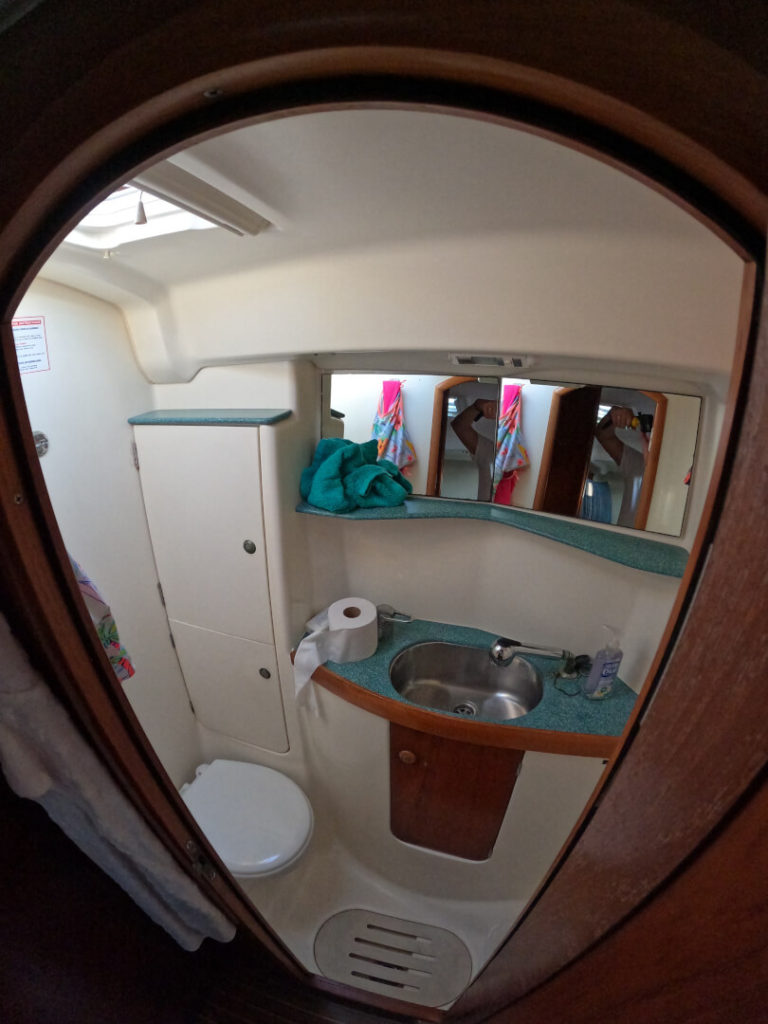
Unlike, the stern head, the holding tank in the forward head is easily accessible in a cabinet next to the sink. Since there are no tank monitors on this boat, this access allows you to tap the tank wall to determine how full it is…remember what I said above: you when these tanks fill up, they will overflow!

There isn’t much in the way of storage in the forward stateroom with plumbing beneath the sink and a holding tank filling up the closet by the head. A toilet paper holder was installed inside the sink cabient, but it was missing the roller on our charter boat.
Without a dedicated shower stall, the sink faucet doubles as a shower head in the forward head.

Systems on the Jeanneau 43 DS
Engine
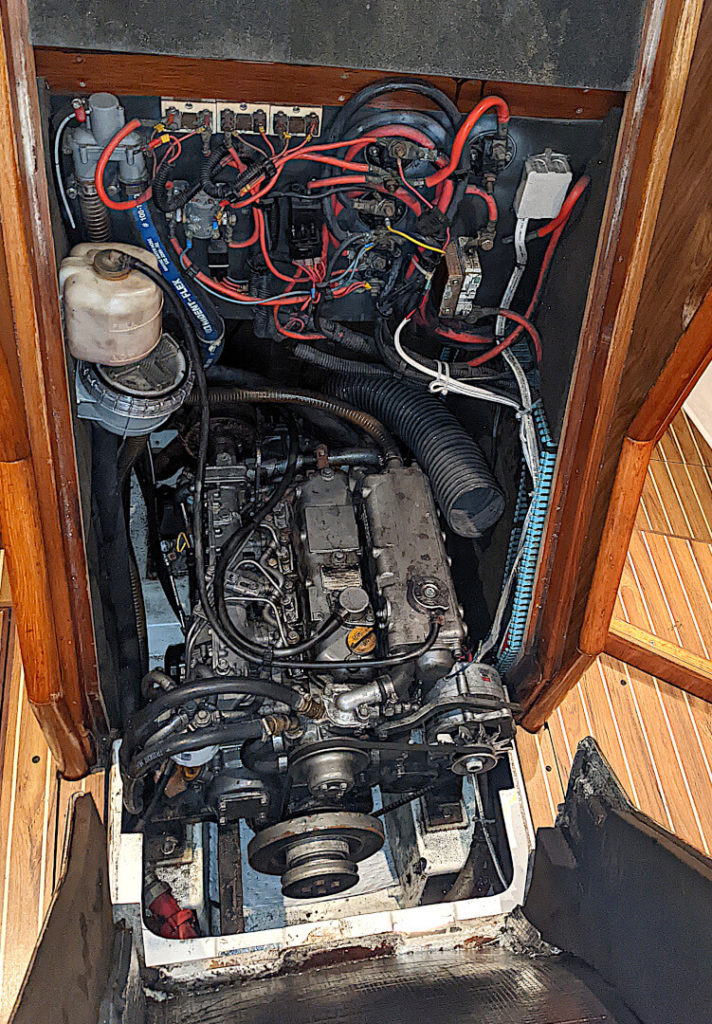
Our charter boat was equipped with a 55-horsepower Yanmar diesel, model 4JH3E. In this spec, it is a naturally aspirated 2 liter with 4-cyclinders. The Jeanneau 43 DS can be ordered with 75-horsepower turbocharged version of the same engine. The 75 hp motor seems like a hot engine for a boat this size. After running the 55 hp motor, we confirmed that the base engine is more than sufficient.
The Jeanneau 43 DS is a shaft drive in which a straight drive shaft runs from the engine, through the hull and attaches to the propeller. This traditional design results in the prop being mounted at a slight downward angle that reduces efficiency and increases prop walk. The latter is not an issue on Cupcake because of her feathering prop mentioned above.
Inspection/access
Like most monohulls, the engine on Jeanneau 43 DS is located beneath the companionway steps. It can be accessed by opening two latches and swinging the companionway steps forward. The oil, dipstick, coolant reservoir, belts, and sea strainer can all be accessed from the port side of the engine, making daily engine checks easy. The sea strainer is mounted above the waterline so that it can be opened and cleaned without closing the seacock. However, the coolant reservoir is frustratingly mounted just above it. So that has to be removed (it just slides up) and placed in a secure spot to do this work. In the San Juan Islands, the sea strainer must be checked often. We had something to clean out of it every day.

How Fast is the Jeanneau 43 DS?
With a length at water line of 37.5 feet, the Jeanneau 43 DS has a theoretical hull speed of 8.3 knots. We were able to cruise at about 7 knots with the 55-horsepower Yanmar diesel running at 2,900 RPMs while towing a dinghy. I say “about” 7 knots because, as usual, our water speed transducer wasn’t working properly, and the San Juan Islands have very strong currents. So, we saw GPS indicated speeds ranging from 3 to 13 knots and I’m estimating what our actual water speed was.
According to factory performance curves, we were only getting 25hp while burning 1.4 GPH of diesel at our 2,900 RPM engine speed. The engine is rated to cruise continuously at 3,650 RPMs, where it will put our 47 horsepower, but burn 2.75 GPH. That should be more than enough power to find the theoretical hull speed around 8 knots. However, the engine sounded very comfortable at 2,900, and the charter company told us that going much over 3,000 results in lots of fuel burn for little return in boat speed. It is normal to use a lot more power (and fuel) to squeeze out that last knot of hull speed.
So looking at the spec for the turbo engine: it would run at 2,500 RPMs to get the 25HP we were using to cruise, but burn slightly more fuel at 1.5 GPH. Similarly, to get to 47 horsepower with a turbo, we would only need to turn 3,250 RPMs, but again burn more fuel at 3GPH. So there doesn’t seem to be any real world advantage to the more costly, more thirsty, more maintenance heavy turbo engine.
Jeanneau 43 DS Fuel Efficiency
on our 5-day cruise, we put 17.5 hours on the engine and consumed 21.65 gallons of fuel. So we consumed 1.25 gallons of fuel per hour. 15 of the hours were under way with the rest at anchor with no load. So the factory rating of 1.4 gallons per hour at 2,900 RPM is about right, or even a bit high. With a 54 gallon fuel tank, the engine could make a 7 knot cruise for 38 hours or 265 miles before running dry. I never plan on using more than half of my fuel, nor do I count on gauges to be accurate, in case I run into unexpected conditions or burn more fuel than expected. So our four day trip was about as far as I’d plan to go without refueling.
How Loud is the Jeanneau 43 DS Engine
Under way, the engine was surprisingly quiet from the cockpit. However, when going down below into the cabin, there’s quite a racket from the engine and all the rattling cabinets. Some of the rattling on our boat was exacerbated by a few missing screws in the floors and paneling. You’ll definitely want to take the forward bunk if you plan to sleep while under way.
Electrical

Our test boat has a dedicated starting battery, isolated from the house batteries. This design ensures that both battery banks will always charge when the engine is running, but you cannot discharge the starting battery with any system aside from the engine.
The electrical panel is very thorough. There’s one panel fort the 120 volt system with breakers and a voltmeter. Two additional panels contain breakers for the 12 volt systems. Everything but the anchor windlass (controlled at the batteries) and the bilge pumps can be disconnected here. In some cases, maybe there are too many breakers. There are three separate breakers for cabin lights, but they are labeled “1, 2, and 3,” so it isin’t obvious which lights each controls.
Cupcake was equipped with 120 volt outlets throughout the boat that only worked on shore power at the dock. Our boat had a 700-watt portable inverter mounted at the nav station. This inverter is not integrated with the shore power outlets, so you’ve got to plug directly into the inverter. Unfortunately, the inverter is mounted below a small lip in the wood trim. This makes it hard to plug in anything other than a standard plug. We had to trim some plastic off of an extension cord to be able to use if for a CPAP machine.

Our boat came with a 50-foot shore power cable. You’ll need every bit of it to run the length of the boat anytime you dock bow first because the receptacle is at the stern.
There were three 12-volt cigarette lighter outlets on the boat. One at the nav station, one on the instrument binnacle at the helm, and one on the engine controls. There were no USB ports, so we used an adapter at the nav station to charge our phones and cameras. With six people aboard, we had to charge in shifts, and could have benefited from a USB adapter with more than two plugs.
I’m not sure what combination of undersized batteries or alternator, worn out batteries, or power thirsty electronics we had, but we were very low on power after one night at anchor. Our house batteries lost some power while under way on our first day (13.5 amps to 12.8 amps), then dropped to 12.0 amps while we were anchored (and off the boat) for 5 hours. We ran the engine before bed and got the batteries back up to 13.2 amps to wake up at 12.5 amps and run them down to 12.0 amps before casting off. Bottom line, this boat needs to be docked or its engine run daily to support its electrical systems.
Lighting
Being an older design, our boat was equipped with halogen light fixtures. The light switches were hard for us to find at first with most mounted on the ceilings near doorways. The salon switch was connected to 7 lights while the galley switch had only 2. At night we got enough light from the 2 fixtures in the galley that we could leave the other switch off and save some electricity. The nav station has three independently operated lights, two red and one white. There were four circuit breakers that operated the light circuits, labeled a very unintuitive 1, 2, 3, and 4.
Ventilation
The forward stateroom is equipped with two fans. One for the V-berth and one for the bunks. The rear staterooms each have a fan. There were no fans in the salon or heads. All fans operate on a single dedicated breaker.
Each stateroom, bathroom, and the salon had an opening overhead hatch. None had screens. They all had a spring tensioned shade with some kind reflective material on one side that was peeling off after 20 years of use. The hatches did not have struts, so they had to be swung all the way open or closed. The salon hatch was hard to operate from inside because the high ceiling made it hard to reach, and especially hard to open gently without dropping it on the deck (and potentially cracking it).

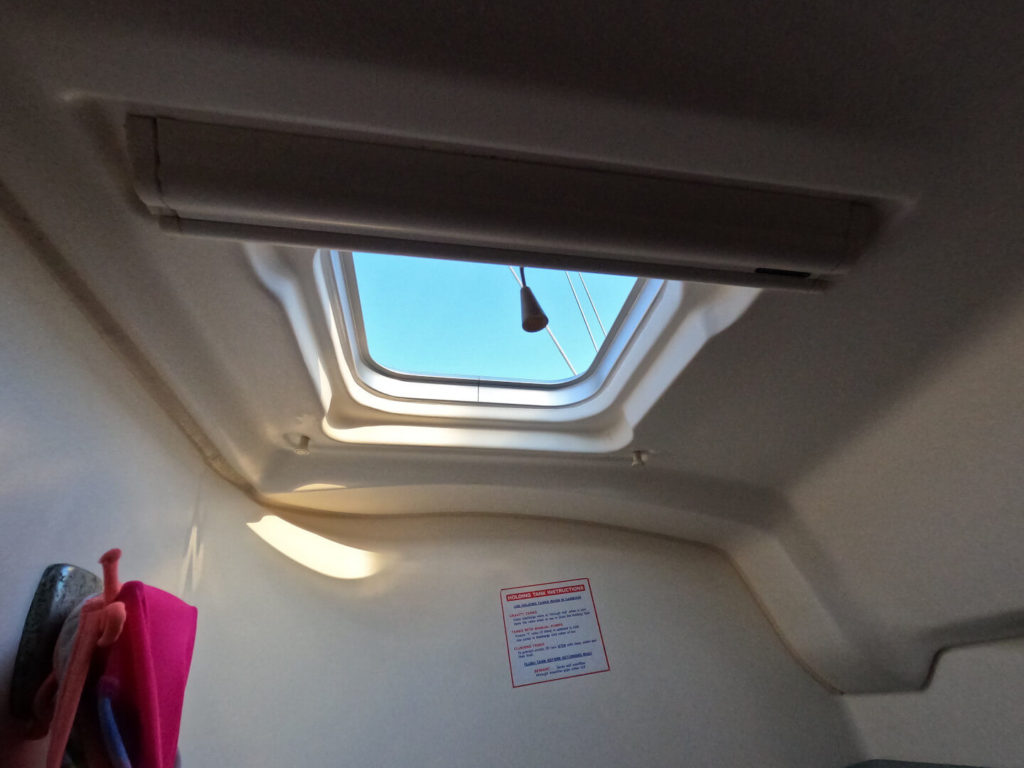
Solar fans were installed on the large hatches in the salon and forward stateroom, but neither seemed to work
Heat
Our boat had vents to accomodate a forced air diesel furnace, but there was not one installed. Instead there were two 120-volt portable ceramic heaters that could be used when on shorepower. Although, when operating on high, they’d use the entire 30 amps available on the shore power system.
Water
Our boat had two tanks, but was plumbed for a third. Hot water comes from the engine exhaust or an electric heater when plugged into shorepower at a dock. The tank kept the water plenty hot overnight to shower in the morning without starting the engine. With the tanks mounted below the cabin floor with no tank monitors, there was no way to know how much water was available. except that we only opened one tank at a time to know when we were half empty.
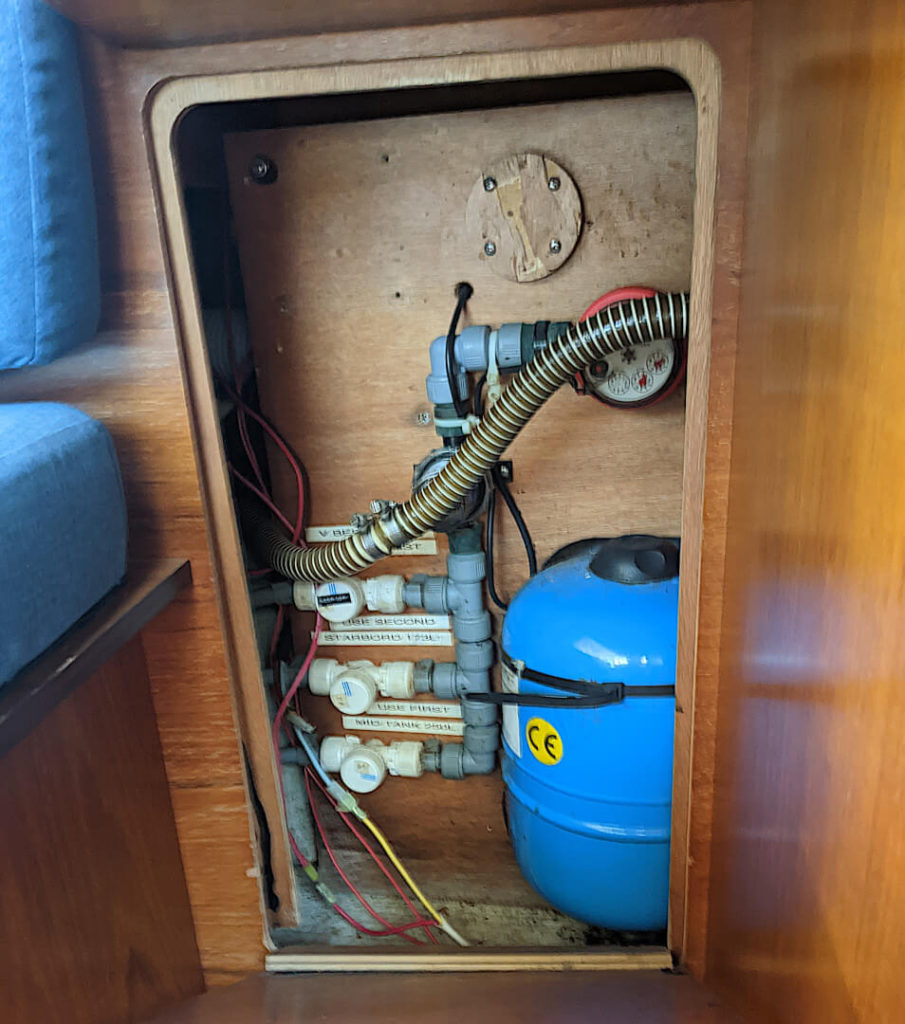
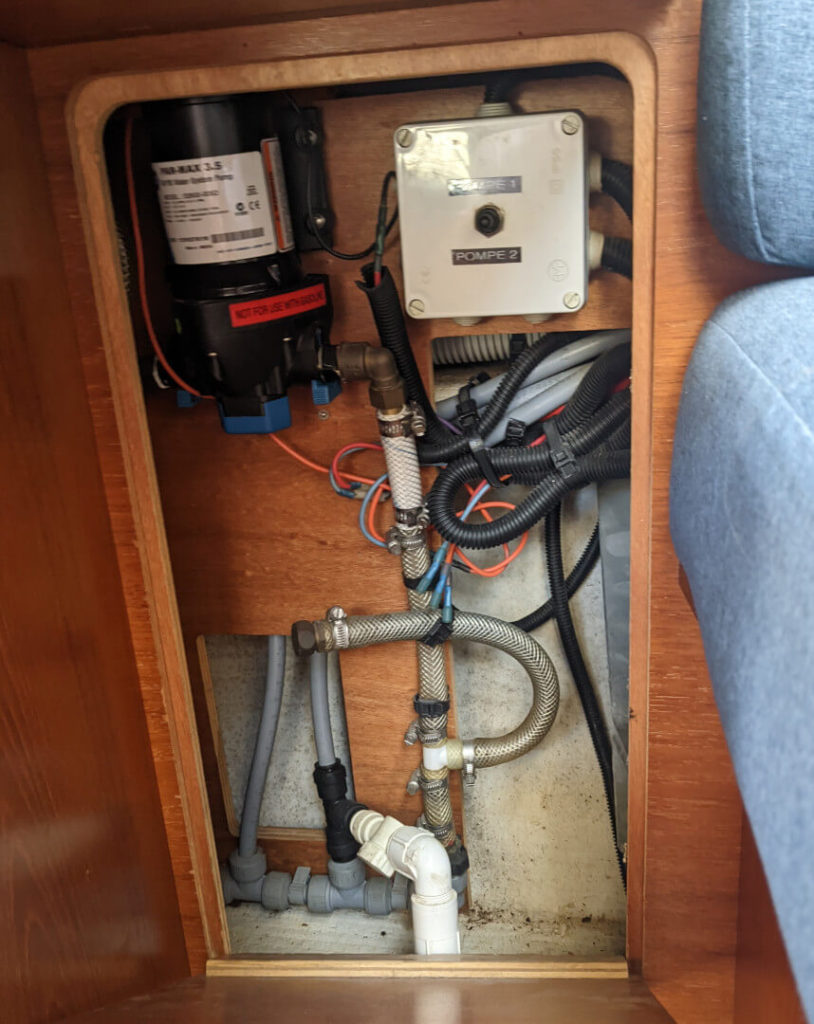
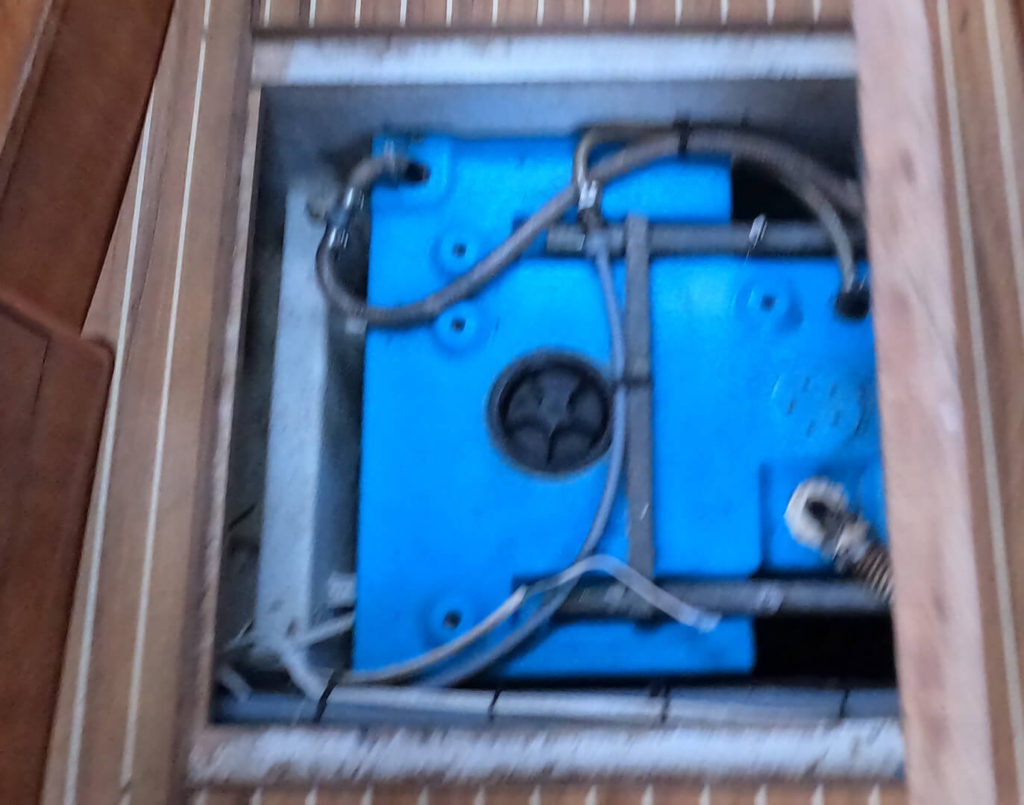
Heads
Both heads are equipped with manually operated Jabsco toilets that use sea water for flushing. Personally, I like the manual pumps better than the electric, but as skipper, they may give the opportunity to do some flushing for your crew. Either because they can’t figure it out, or they pretend not to know how. The manual pump is a bit finicky in that the drain/fill switch must be firmly over to either side to operate; it is a hard switch to move that is easy to leave somewhere in the middle of its travel. So why do I like the manual head over electric ones, like the ones our Leopard 43 Powercat? Efficiency, the manual heads don’t use any electricity and your holding tanks will last longer as the crew will use less water…although be sure to use enough to get waste out of the pipes and into the tanks. That last item, more control over pumping volume, means that you can put a bit of vinegar or salad dressing in the bowl and slowly move it through the system to clean up the seals and get things moving.
Despite being regularly maintained with enzymes, these 20 year-old saltwater heads indeed smelled awful. So, as we always do in our charters, we left the hatches open as much as possible in there to keep the fresh air circulating.
Both showers have manually operated electric floor drains. Once you are standing in a sufficently deep pool of your own filth, stop what you are doing and hold the momentary switch to operate the pump until the water is cleared.
Anchor and Windlass
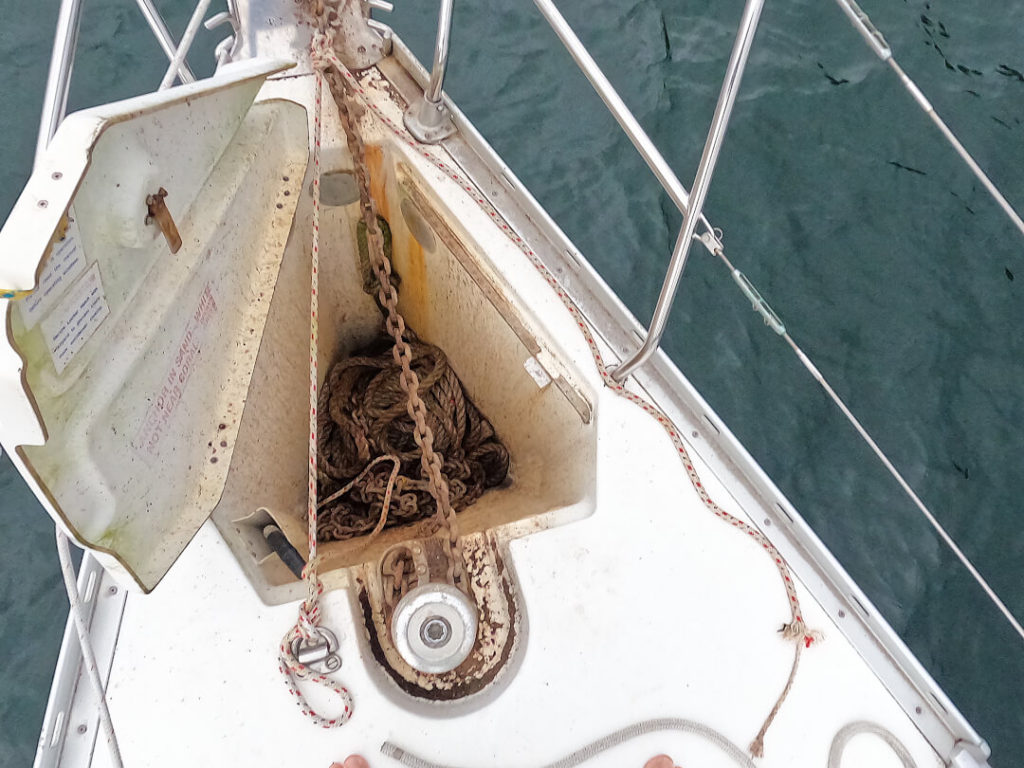
Our boat was equipped with a very powerful windlass. It moved up and down with a firm confidence that encouraged you to keep your hands and feet very clear. While it is common to trip the windlass breaker when pulling an anchor, ours never tripped once. However, when anchored in (feet?) of water, we ran past the chain and into rope. First, we had trouble getting the giant knot between the two rodes through the windlass; then the smaller rope wouldn’t bite on the windlass unless an operator pulled on it for tension. This slowed the process of raising and lowering the anchor, gave me quite a work out, and got me pretty muddy. The 200-foot chain was not marked, but the rope was clearly labeled in 10 foot increments (starting at 210 feet)
Our boat was equipped with a stainless steel Rocna anchor. Rocnas have a good reputation as a multi-purpose anchor. We found if bit into the muddy bottoms in the San Juan Islands with confidence. The Without much of a bowsprit, the anchor had a habit of banging the bow on the way up, but fortunately it was shielded by a stainless panel to keep us from damaging our beautiful boat.
Bareboat Charter Equipment from Ship Harbor
Dinghy
Cupcake came with a very adequate Rigid Inflatable (RIB) dinghy. A RIB has a solid floor and transom, with inflatable tubes on the sides for additional buoyancy. This design provides more seating and load carrying capacity for a given length. It also provides exponentially more stability, won’t scratch the big boat, and doesn’t tend to fill with water and sink when towing.
Fortunately, our dinghy was equipped with an outboard to make longer journeys ashore tolerably fast and free of back seat rowers providing unhelpful instructions. Unfortunately, you have to remove the outboard when underway since the dinghy must be towed…well, you can also lift it onto the deck with the spinnaker halyard if you have a crew suffering from an overabundance of strength and patience. So when we were moored close to shore, we rowed in. This gave George an opportunity to take off his shirt and work on his guns.

Barbecue
Cupcake came with a Magma propane grill that took two people to mount on the cockpit railing without loosing hardware to the sea. This wasn’t the hottest grill, but it was effective at cooking meat without getting the boat hot and stinky. When cooking hot dogs, cook them parallel to the grates so they don’t roll off!
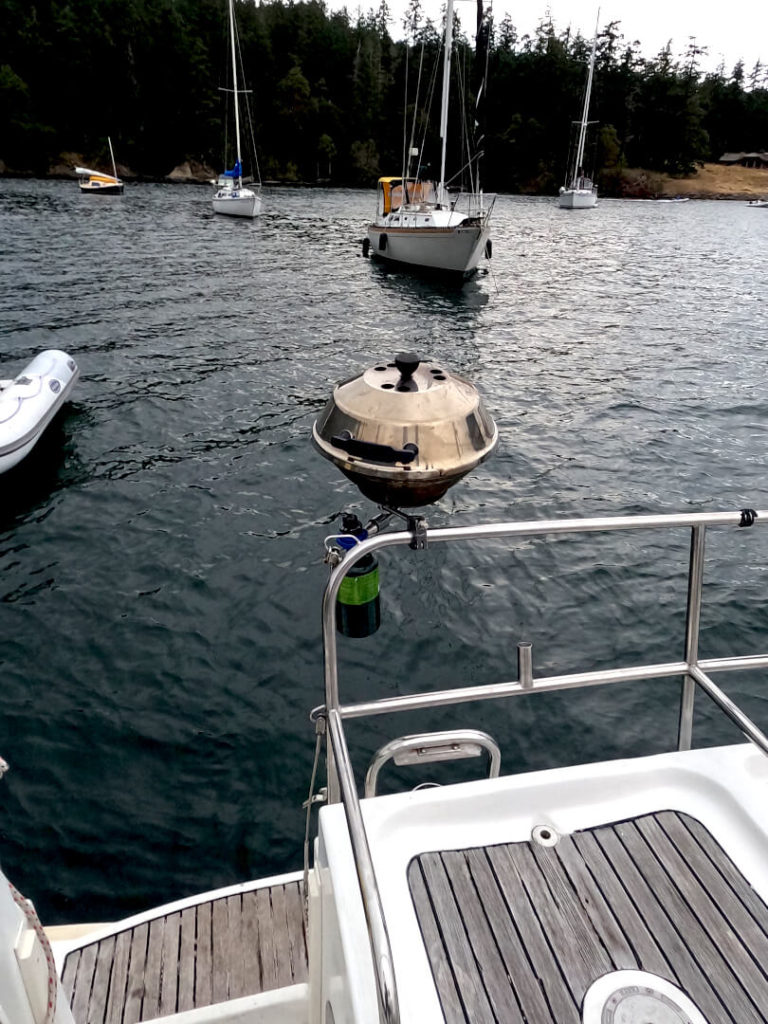
Crab Pot
Cupcake came equipped with a crab pot. Dungeness crab, the best tasting crab on earth, are plentiful in the San Juan Islands. However, we didn’t end up crabbing, and in hindsight should have left the pot at the dock to make more room for other crap.
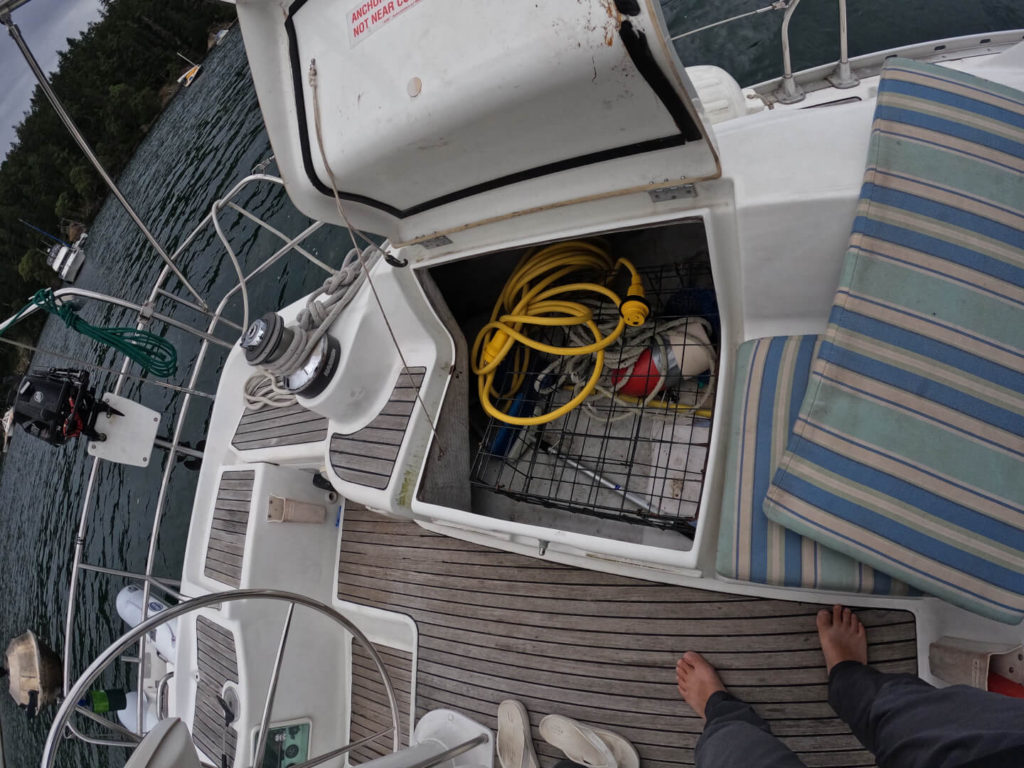
Cordless Vacuum
We always have dirt and sand getting tracked around our charter boats and often we don’t even have so much as a broom and dustpan to keep after it. And there was the one time that SOMEONE spilled a bag of rice on the floor that got into all the storage bins and under every nook and cranny. The vacuum would have been welcome on any charter.
Life Jackets
While we were technically compliant, the life jackets stowed beneath the settee were suitable for emergency use only. Whenever we can, we pack self inflating jackets so that we can cruise in comfort without sacrificing safety.
Tools and Spares
Our boat came equipped with a generous set of tools and spares stored beneath one of the nav station chairs.
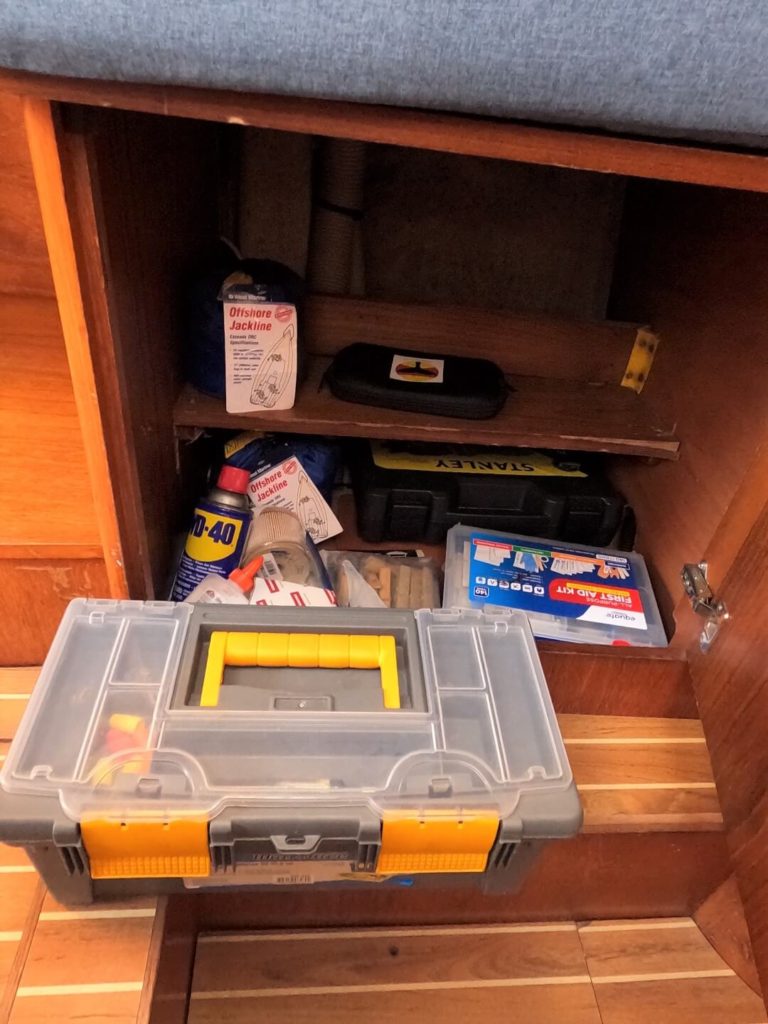
Linens
The charter company left the linen order in a bag on the forward berth, giving your crew the privilege of making their own beds. We were also required to strip the beds and return the linens to the charter office when turning in the boat.
Features to Look for in a Jeanneau 43 DS
From the factory, this is a pretty straightforward, well-equipped monohull. With that said, here are a few items that are important to me:
- With a 6.5′ draft, don’t leave the dock without a good chartplotter at the helm to keep you in deep water. We welcomed the updated unit over the monochrome nav station mounted system that Cupcake probably started life with.
- The 55 hp engine will save fuel and maintenance, with little, if any loss in cruising speed.
- The in mast furling main made getting the sails up fast and easy. More importantly, with an inexperienced crew, I liked the peace of mind that I could furl the main from the cockpit rather than climbing up to put in a reef if winds picked up. These benefits outweigh the additional speed from the larger conventional sailplan for my crew.
- A barbecue keeps the cabin cool and stink free, especially on boats without air conditioning…or boats that catch lots of fish.
- We could have made use of a generator or larger alternator. The only resource we were tight on during this trip was electricity.
- The feathering prop was a dream come true in the marinas…coupled with Cupcake’s generous rudder, I’d accept this configuration in lieu of a bow thruster or twin engines anytime.
Jeanneau 43 DS Problems
Our test boat was over twenty years old with an unknown number of those in charter service. This gave us a good opportunity to see how a production boat stands the test of time. While this was a faaaar cry from a meticulously maintained Hinkley, I think it fared well given its provenance. With that said, here is a list of problems we experienced on our charter:
- We had a few problems with the helm electronics mentioned above.
- All but one hatch had no struts to hold them partially open, likely broken in the past.
- Windicator was not working correctly, showing wind speed close to zero with incorrect wind direction most of the time. Thomas Senator noted in the comments below that this could be related to the malfunctioning knotmeter.
- Water speed indicator was way off, never showing a water speed greater than 4 knots.
- Sometimes the tachometer got stuck at the cruising speed, and wouldn’t move when adjusting engine speed up or down a few hundred RPMs. I had to drop the engine to idle then re-accelerate to get an accurate reading of engine speed.
- The cabin had a bit of a mildew smell when we first opened it up, but once aired out, it was totally fine.
- The fuel gauge seemed to work at first, coming up to 100% after starting the engine for the first two days, then stayed below zero, not moving at all.
- The aft staterooms had some wires crossed in the light switches. So the port stateroom lights only worked when the starboard light switch was on…or something confusing like that. Thomas Senator noted in the comments below that there’s a switch in the engine compartment to set toggle the lights between one and two cabin configurations. A brilliant feature when used properly.
- The fans in the forward stateroom were disconnected from their wiring. We had a few other lights with finicky switches, but always had a sufficient amount of lighting.
- We had a squeaky alternator belt. I was able to use the provided socket set to tighten the belt, but the bracket felt a bit flimsy. So I was very careful not to overtighten it and lose the alternator altogether.
- Our dinghy outboard had one of its bolt handles broken off, requiring us to use channel locks to tighten. Actually, we tried to use our bosun’s knife first, but broke that!
- One of the dinghy oars was broken and taped back together, so the paddle was not properly aligned to the water.
- The tow eye on the transom was not mounted at the centerline, so our dinghy dragged a bit sideways.
- The forward head smelled pretty awful. We also were never able to pump any waste out of it despite the children claiming to have flushed some goodies in there. Prehaps the two were related. Regardless, keeping the door closed and the hatch open kept the rest of the boat from stinking.
- The latch for the forward stateroom door was broken, so it did not securely close.
- Some of the cabinet locks were finicky and either got stuck closed or wouldn’t stay closed.
- Some curtains were missing and some had snaps that were too corroded to remove.
- One of the rungs on the swim ladder was missing.
Alternatives to the Jeanneau 43 DS
The Jeanneau 43 DS ended production 2006 when it was succeeded by the 44 DS. The newer boat has a very similar layout, but with a modern design interior and a swoopy exterior: sort of the opposite of the lines in the 43. More recently the Deck Saloon type has been discontinued, leaving the classic Sun Odyssey line as the only cruising model from Jeanneau.
The original Jeanneau Deck Saloon was also offered in a 40′ model that did without the separate shower stall and forward bunks found in our 43.
The Jeanneau design reminds me a lot of the older Beneteau Evasion 36, which brings a bit more function to the deck saloon concept with a lower helm in the salon. I’d love to take that on a cold, wet cruise in the Pacific Northwest.
How Much Experience Do You Need to Rent a Jeanneau 43 DS
You should have some experience in docking boats over 40 feet, especially if your itinerary includes much docking as this is when the boat makes her size known. With that said, the Jeanneau 43 DS is a very forgiving sailboat. So I think that experience on any type over 40 feet would be suitable, so even if you’ve only handled outboards or twins, or catamarans, you’ll be comfortable on this boat.
With a modest sailplan, both sails on furlers and a high mounted boom, she is easy to sail in the control of a short handed or lightly experienced crew. Even without the aformentioned design, a monohull is more forgiving to sail in heavy winds than a catamaran because the risk of capsize is all but eliminated. Furthermore, the predictable and precise ability to maneuver the boat within close quarters makes her accessible to less experienced mariners.
Where Can I Rent One and How Much Does it Cost
We rented Cupcake from Ship Harbor Yachts in Anacortes, WA. Unfortunately, they are not operating for the current charter season. A sister ship is available nearby in Bellingham, WA from San Juan Sailing. Illumune rents for as low as $4,400/week in the off season and $5,500/week during the high season from June-August. San Juan Sailing also offers partial week charters based on availability, but the rates get pretty steep and will be hard to find during the busy Summer season. On the bright side, pre-boarding the night before your charter is only $60.
Conclusion
The Jeanneau 43 DS is an easy boat to live with on a charter with adequate tankage and storage, capable systems, lots of private space in the staterooms and heads, casual cruiser friendly sailing equipment, and a very maneuverable hull. Packing all of this into a 43 footer means lots of steps, limited open space, and layout that isn’t always intuitive. Here in the Pacific Northwest, where motoring is more common than sailing, the strong, quiet Yanmar got us from port to port on time, on budget, with our hearing intact. If I’m being honest, I step off the boat less enamored by the ‘deck saloon’ design than before I arrived. I still like the handsome exterior, but didn’t find much value in the cabin…although my noggin never came into contact with the boat, so maybe its one of those things I won’t fully appreciate until I’m on another boat with low overhead.

Nice write up. a few points
1)The Jeanneau 43 DS never came with ” two helm configurations: twin helms at the stern ” Only the single helm.
2) A possible reason your electronic wind instruments might have not been accurate is because your knotmeter is not accurate or calibrated and when you hit the button for “real wind speed” not apparent wind speed it will be off because it uses the knotmeter speed for calculations.
3) Your aft cabin lights might have been set so both cabin lights come on with either switch because a “switch in the engine compartment” was set wrong for a two aft cabin set up. It can bet set so both side lights come on and that appears to be what was happening. (That is for when you remove the wall between both aft cabins and want lights for one big room)
Thanks for the tips! I went back and wasn’t able to find any boats with a twin helm, so I’ve corrected the post.